From the late 1980s to the mid 1990s Rickenbacker dedicated a sizable percentage of their production capacity to special artist “Signature Limited Edition” guitars, developed with the artist in question (or their estate). These guitars could be evocations (of varying fidelity!) of guitars strongly associated with an artist, or entirely new creations built to the artist’s specifications. While the peak of this “Limited Edition” era passed in the mid 1990s, a handful more have appeared since then. Here they all are.
Pete Townshend 1998PT

THE PETE TOWNSHEND LIMITED EDITION
SANTA ANA, CALIFORNIA (June 1, 1987)-Rickenbacker International Corporation announces the acceptance of orders for the PETE TOWNSHEND LIMITED EDITION. The instrument is similar to the guitar Pete Townshend used in his "Mod" and "Maximum R & B" days with the WHO during the mid-1960's
The handmade instrument features Rickenbacker's hand-shaped slim" fast action" neck from the 1960's; violin sound hole; 21 frets; small headstock; three vintage pickups; Rosewood fingerboard; semi-hollow body and neck made from solid Maple; plus, Rickenbacker's exclusive dual truss rod system. The necks are hand-shaped by the same craftsmen that built the originals in the1960's.
The Company is authorized to manufacture 250 of these instruments. The guitars will be individually numbered and accompanied by a Certificate of Authenticity and Origin hand signed by Rickenbacker President, Mr. John Hall.
The Company will officially introduce the instrument at the 1987 Summer NAMM show in June. The list price is $1225 with a custom hardshell case at $129. Instrument numbers will be assigned as the orders are received.
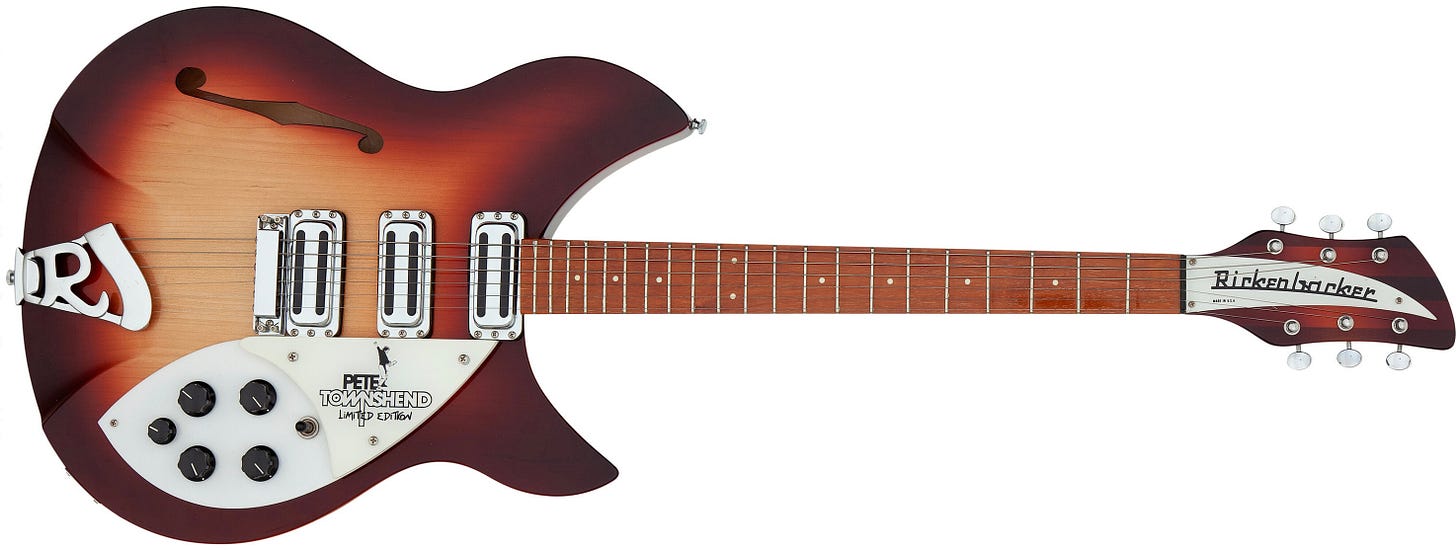
As the first of the Signature Limited Edition models, the 1998PT would birth the “inspired by/recreation of” theme many of the subsequent models would take. Although this one falls squarely on the “inspired by” side of that equation.
Townshend primarily played (and of course smashed) 1998s and 1993s during The Who’s early years. Indeed, most of the most famous images of him wielding a Rickenbacker—including the “Maximum R&B” poster—feature those two models. While he did own at least one (and maybe 2) 1997s, it/they were among the last used during his “Rickenbacker” period. So it’s not surprising that his Signature model would be modeled after the three pickup 1998.
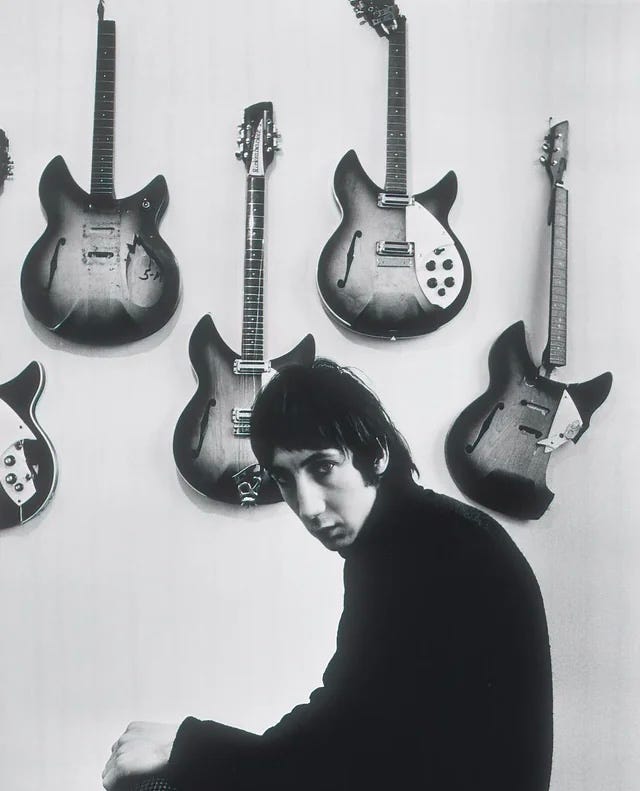
And the first thing he did to those 1998s (and 1997s) was to remove the Accent tremolo arm—and in fact replace the Accent entirely in some cases with whatever tailpiece was handy. Add to that the fact that most of the 1993s he owned—excluding the first, of course—featured “R” tailpieces instead of trapezes, and it’s not surprising that this “inspired by” guitar features an “R” tailpiece instead of an Accent or a trapeze—something no original 1998 did.
So in many ways the 1998PT is a bit of a combination of a 1998 and a 1993. And while it is a unique combination of elements, all of those elements were “off the shelf”.
The 21 fret square-heeled/f-holed Rose Morris 1997 reproduction model had appeared in the line in 1986. Add a third pickup, replace the trapeze with an “R” tailpiece, and add a special pickguard and presto! You have the 1998PT.
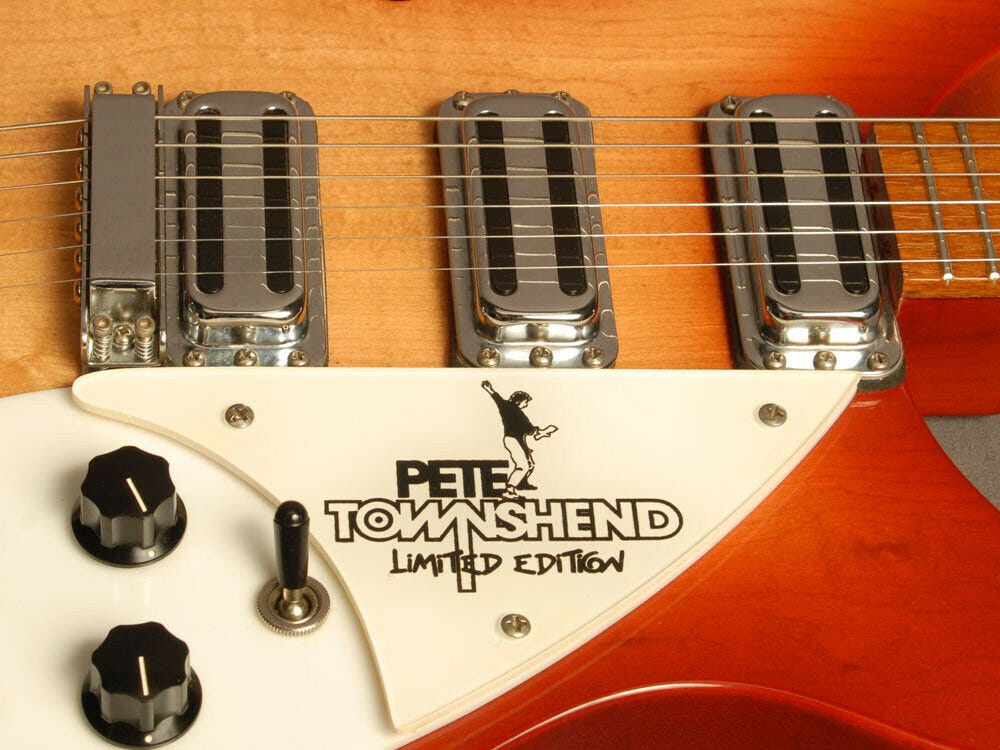
As the first of the breed, they hadn’t really settled on a branding “look and feel” yet, so the 1998PT is one of only two Signature Limited Edition models to not feature a…signature. It did, however, set the template of special artwork back printed on a clear upper pickguard. Over time the white paint used yellows slightly, leading to a color mismatch between upper and lower guards. The truss rod cover is the “standard” reissue model white plexi, and the tuners are the Schaller “Kluson-ish” tuners in use on the V-Series Vintage Reissue models.
It should also be noted that the “vintage pickups” used on this and most of the later Signature Limited Edition models were the period “12k/hot toasters” that were of significantly higher output than the pickups found on the models they were emulating.
250 were produced between mid 1987 and early 1988, and all sold pretty much immediately.
Roger McGuinn 370/12RM
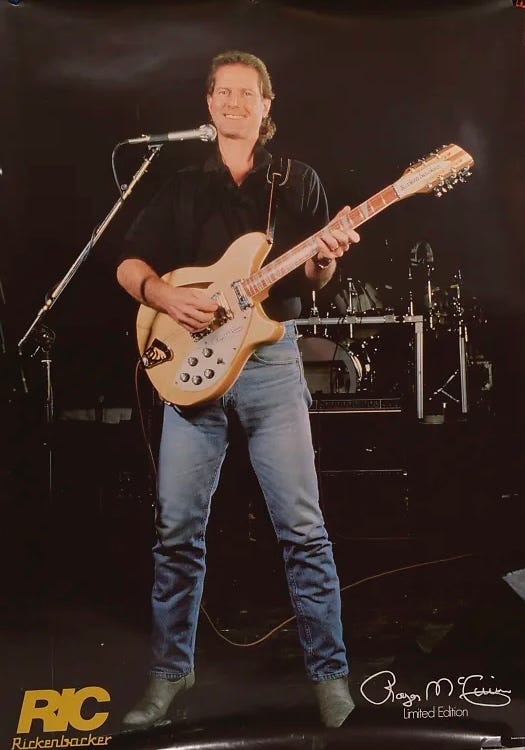
Secret Weapon of the 60's
Santa Ana, California (December 1, 1987) Rickenbacker International Corporation announces the acceptance of orders for the Roger McGuinn Limited Edition. The instrument is similar to the twelve string guitar Roger McGuinn used during his days with the quintessential rock group the Byrds, which helped mold the sound of the 1960's. The company has introduced its newest limited edition as the "Secret Weapon on the 60's" because it contains customized electronics and circuitry which Roger developed and installed in his original instruments to produce the distinctive sound which set a standard for twelve string guitars and survives in today's music. The customized electronics is being offered for the first time by Rickenbacker.
The handmade instrument offers a number of features which make it stand out in the Rickenbacker product line including a hand shaped 1960's style "fast action" neck; 21 fret full inlaid rosewood fingerboard; three vintage Toaster Top™pickups; semi hollow body and neck made from solid maple; Rickenbacker's exclusive dual truss rod system; the revolutionary 12 string bridge; checker board binding; plus, Roger's customized electronics and circuitry. The instrument is available in Mapleglo, Fireglo and Jetglo.
Roger McGuinn has authorized the Company to manufacture 1000 of these unique instruments world wide. The guitars will be individually numbered and accompanied by a Certificate of Authenticity and Origin hand signed by Rickenbacker President, Mr. John Hall. The first 250 certificates will be signed by Roger McGuinn.
"I haven't been so excited about a guitar in years. This guitar is hand made in America and incorporates some features that I've always wanted but haven't been able to find until now. The active circuit faithfully reproduces the sound that we used to take hours to perfect in the studio. The 12 saddle bridge allows for perfect intonation up the neck. I hope you enjoy playing it as much I do."
-Roger McGuinn
The Company will officially introduce the instrument at the 1988 Winter NAMM show in January. The list price is $1,399, with a custom hardshell case at $129. An optional version without enhanced electronics is available at $1,299. Instrument numbers will be assigned as orders are received.
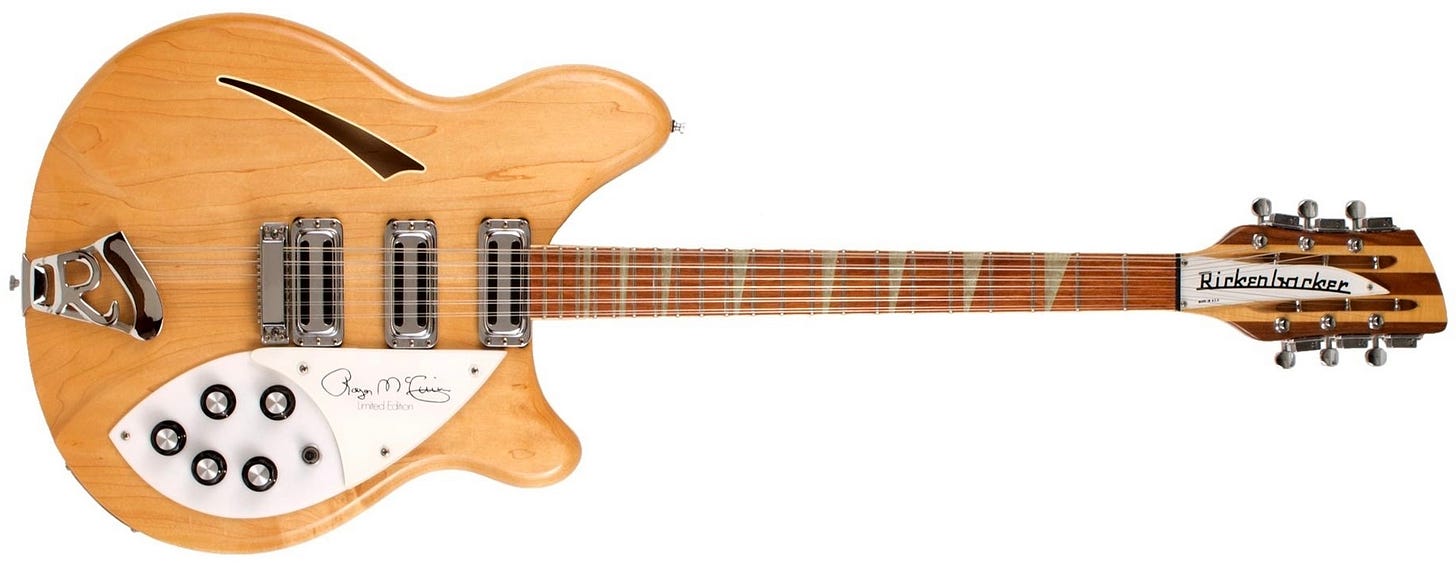
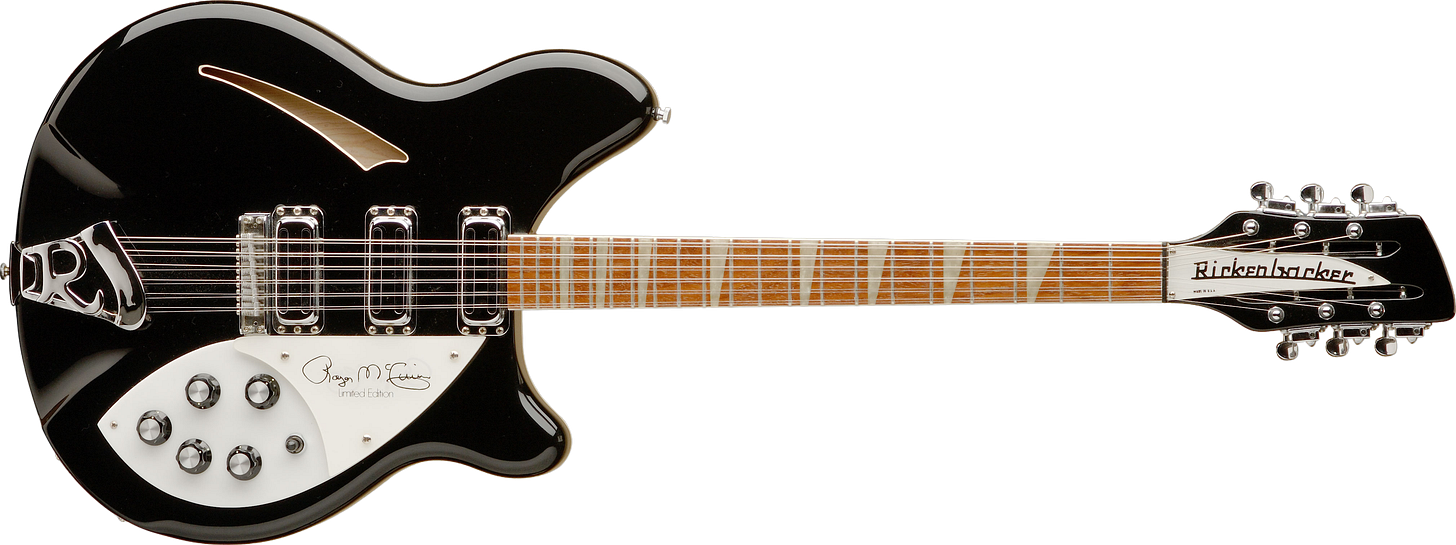
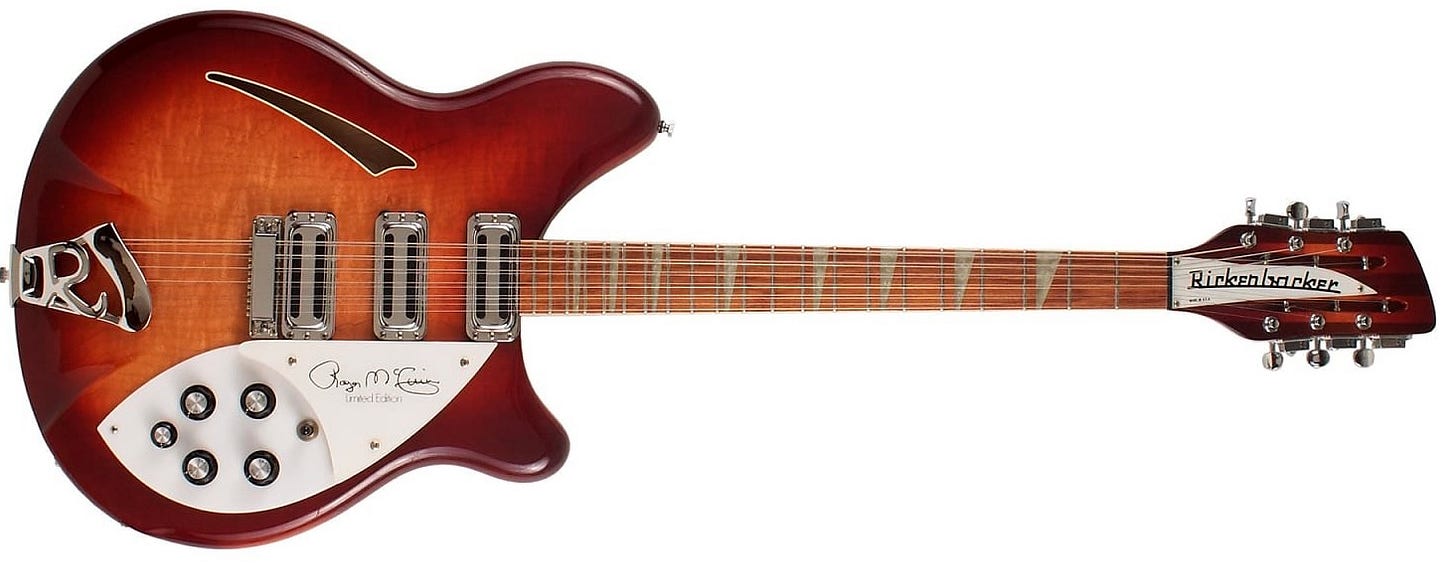
The next Signature Limited Edition would follow the same “inspired by/recreation of” template the 1997PT set. Perhaps no other artist is as indelibly linked to the Rickenbacker 12-string “sound” as is The Byrds’ Roger McGuinn, so creating a reproduction of his 1960s 370/12s was a logical next choice.
And this was far less of an “off-the-shelf” mishmash than the 1997PT had been. For starters, there had been no 21 fret “round top 360” model produced since 1973, so new tooling was required. And then there’s the electronics.
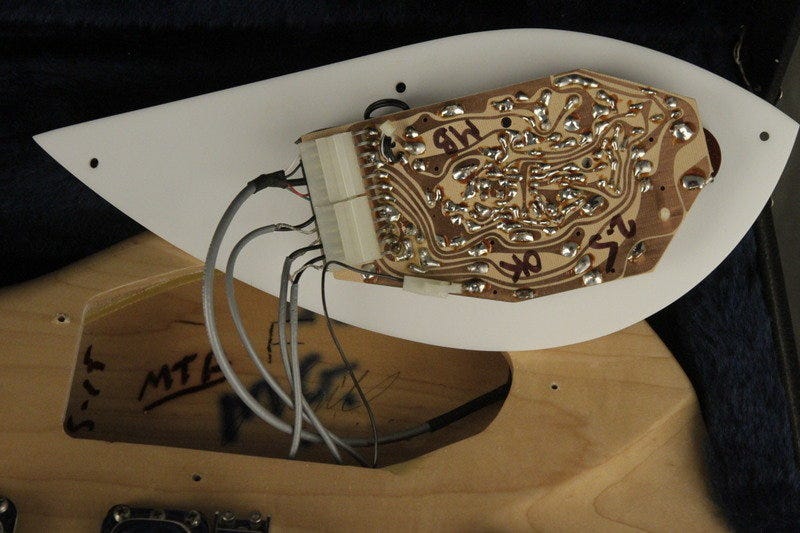
McGuinn made significant modifications to his guitars back in the day—so much so that “Byrd Wiring” was an option that could be ordered from the factory in the mid to late 1960s. The 370/12RM took this to the next level, adding an onboard compressor with a circuit not dissimilar to that of the MXR Dyna Comp compression pedal but with a preset fixed output.
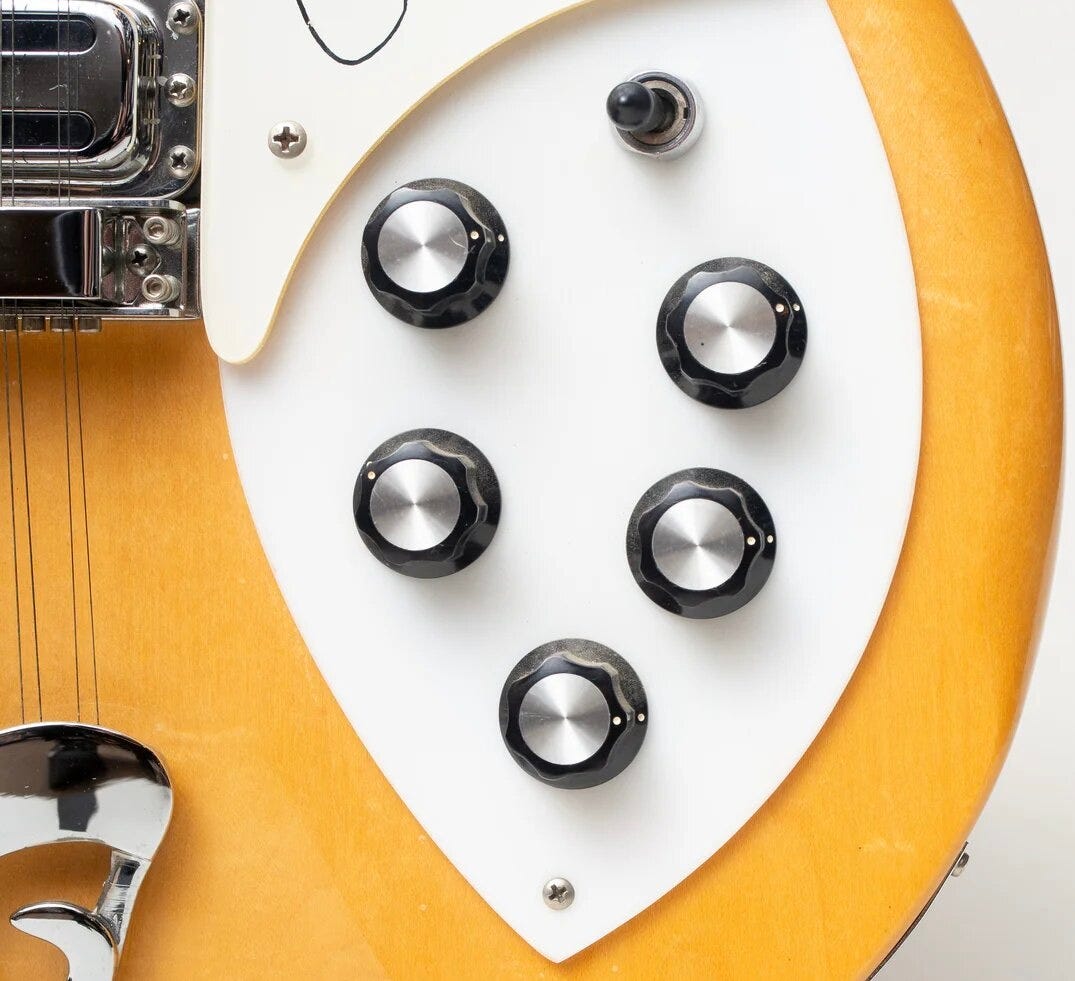
With this onboard compression came a unique control layout. Clockwise from the 3-way switch the controls are as follows:
Three way pickup selector
Neck/middle
All
Bridge/middle
Neck pickup volume
Middle pickup volume
Bridge pickup volume
Tone/compression 6-way rotary switch
“Dark” tone/no compression
“Medium” tone/no compression
“Clean” tone/no compression
“Medium” tone with compression
“Clean” tone with compression
“Treble Boost” with compression
Master Volume
The compressor was only active on the “standard” output jack. Replacing the 9V battery that powers the compressor requires removing the entire pickguard assembly. The compressor circuit becomes quite noisy as the battery loses charge. The model also came without the onboard compressor equipped, and these can be easily identified by the “standard” 5 knob/1 switch control layout (seen on the Fireglo example above).
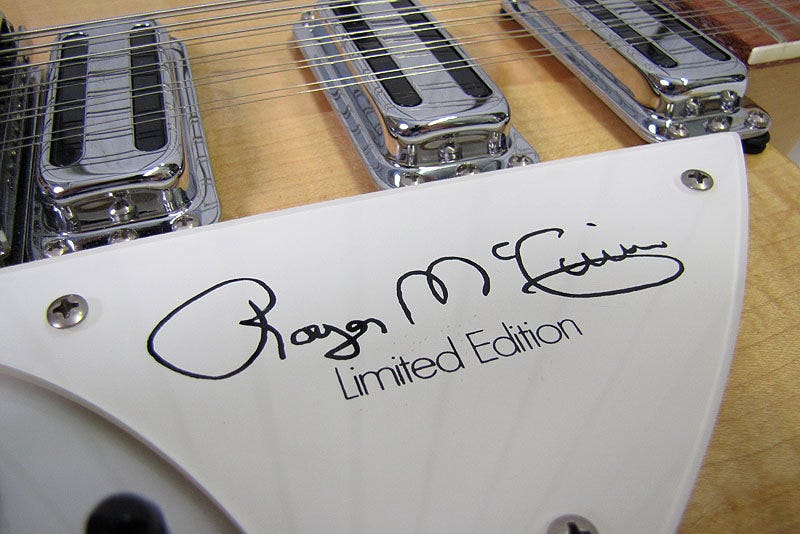
A new branding theme would appear on the 370/12RM, with the McGuinn’s signature and “Limited Edition” screen printed on the backpainted upper pickguard. This would carry over to all subsequent models.
Like the 1997PT, the 370/12RM featured a plexi “vintage”’style truss rod cover, Schaller “Kluson style” tuners, and period “12k/hot” toasters. The model also got 60s-era checkered back binding. And the 370/12RM notably introduced a new 12 saddle adjustable bridge—the first in the company’s history.
1000 were produced between early 1988 and mid 1990. A number of “warranty/extra” bodies were built for the run and later built out in late 1990/early 1991. Such guitars are commonly referred to as “RM overruns”.
John Kay 381JK
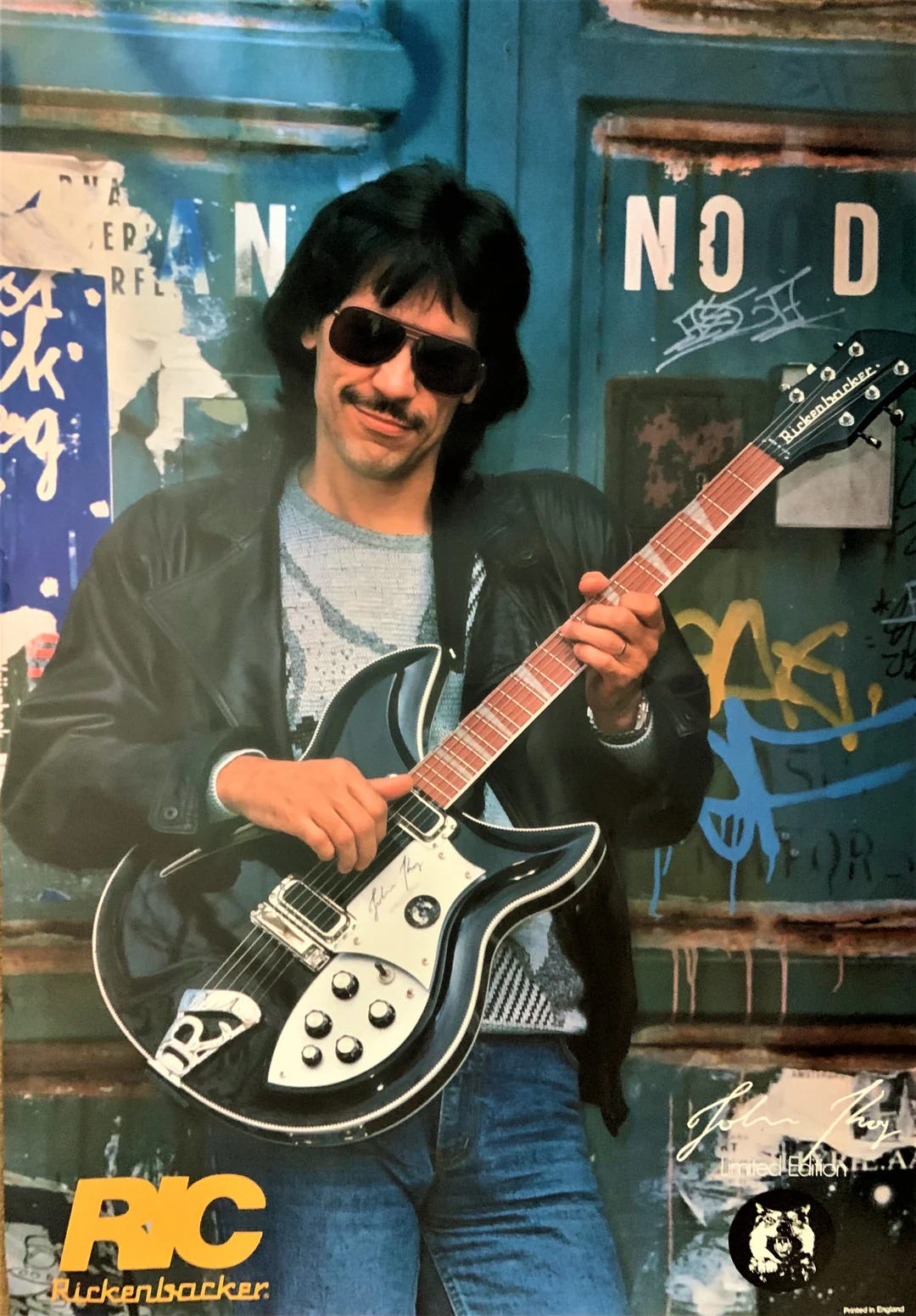
Santa Ana, California (October 1, 1988) Rickenbacker International Corporation announces acceptance of orders for the John Kay Limited Edition. John Kay, as founder and leader of the legendary rock group, Steppenwolf, has been an integral component in forming the Los Angeles music scene since the 1960's with such monster hits as "Born to Be Wild". John Kay and Steppenwolf continue to perform to sold out concerts throughout the world.
The John Kay Limited Edition incorporates elements of the Rickenbacker 381 he used in early Steppenwolf days with additions for active electronics and personalized appointments. The instrument features two HB-1's, Rickenbacker's newly designed humbucking pickup, active and passive modes, lead phase switch and a four position rotary switch which offers various combinations of single coil and humbucking pickup configurations. The guitar offers stereo and monaural outputs and includes unique appointments such as silver pickguard, Jetglo finish and silver nameplate.
John Kay offered over 25 years of professional experience in design specifications for this instrument. The Company considers the electronics as leading innovations in offering a variety of tonal qualities and electronic configurations.
"Greetings! This guitar is based on the model 381 which I first played in 1968 and used on various Steppenwolf records. The pickups and electronics have been updated using some of Rickenbacker's most recent advances. As a result, this instrument, while very quiet, has a high output level and a wide selection of tonal colors."
"The look of the guitar is something I am particularly pleased with. Since I am totally color blind, I gravitate towards high contrasts, hence the black and silver combination. I enjoyed designing what I think is a striking instrument, which is made with much skill and care in the USA."
"In these times of stamped out imitations, it is a pleasure to be associated with something genuine and of high quality."
"Hope you feel the same."
A limited number of instruments will be manufactured. Each instrument will be accompanied by a numbered Certificate of Authenticity and Origin. The list price is US$1699. A hard shell luggage case is included.
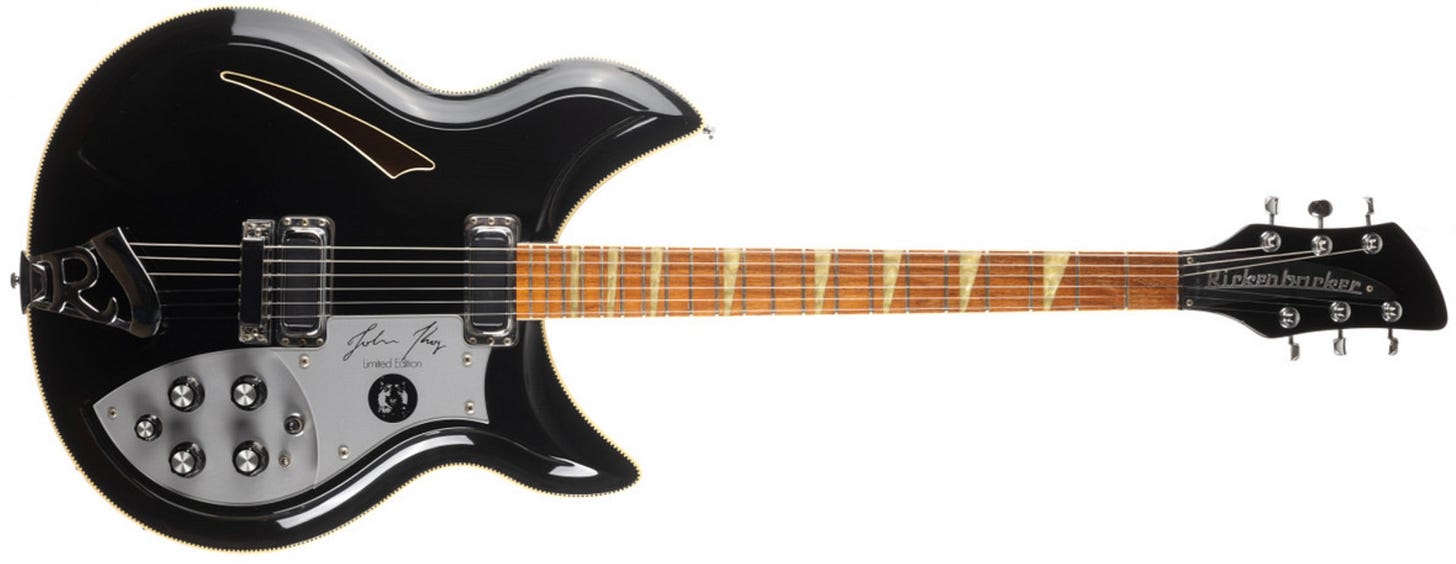
While the 1997PT and 370/12RM followed a “recreation of/inspired by” theme, the 381JK was first Signature Limited Edition to be built to modern specifications developed with the artist. While it used the fairly recently introduced 381V69 body as a foundation, it was its entirely own thing.
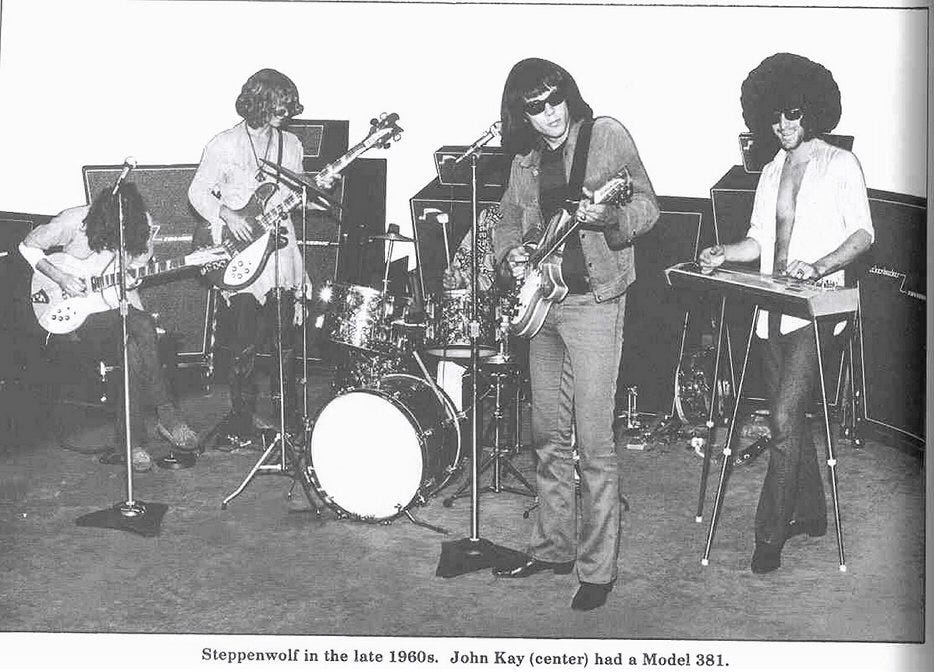
That’s not to say there was no prior association. Steppenwolf had used Rickenbacker-supplied gear in the late 1960s, as pictured here—including Transonic amps and the period 381 Kay is playing above. If you look closely, you’ll see the second guitarist (probably Michael Monarch) playing a 370/12 with Byrd wiring!
So starting with a 381V69 template, the 381JK got a unique black and silver cosmetics package and a one of a kind active electronics package.
The 381JK and the 350SH (more about which in a moment) were the first Rickenbackers to feature a new humbucking pickup: the HB-1. The dual blade design came with a new (for Rickenbacker) party trick: the ability to split coils. This would be taken full advantage of on the 381JK.
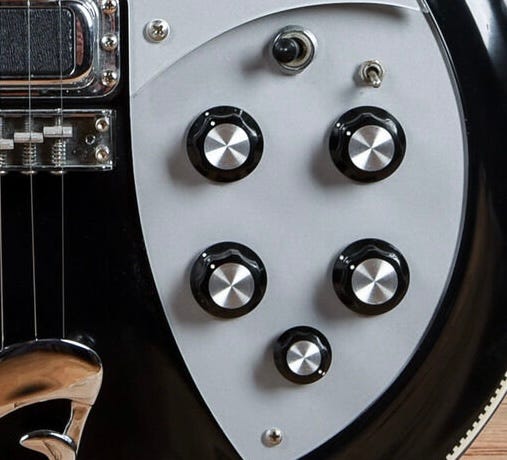
Unlike the unusual layout of the 370/12RM’s controls, the only giveaways that something unusual is happening here are the mini toggle switch and the lack of labels on the knobs. But the controls here are quite complicated, and provide numerous tonal possibilities. Clockwise from the pickup selector switch we have:
Pickup selector switch
Neck pickup only
Both pickups
Bridge pickup only
Bridge pickup mini toggle
Neck volume
Bridge volume
4-way rotary switch
Master tone
Master volume
The rotary switch requires a deeper dive!
Position 4 enables the active electronics. In this position—whether in mono or stereo output mode—both pickups are both humbucking mode and an active noise cancellation circuit is activated. When stereo output mode is selected, the master volume and master tone controls are inactivated. When standard/mono output is in use, the master volume remains inactive but the master tone knob provides a treble boost. The bridge pickup mini toggle will put the pickup in or out of phase. Rick-O-Sound stereo output is only active in position 4.
In positions 1, 2, and 3, the guitar is in passive mode, the coils are split to put the guitar in single coil mode, and the pickup selector switch and individual volume knobs are disabled. Position 1 has just the neck pickup active, position 2 has both pickups active but wired in hum cancelling series, and position 3 is bridge pickup only. The mini toggle in inactive in position 1, in position 2 it puts the bridge pickup in and out of phase, and in position 3 it selects which coil is live. Complicated enough for you?
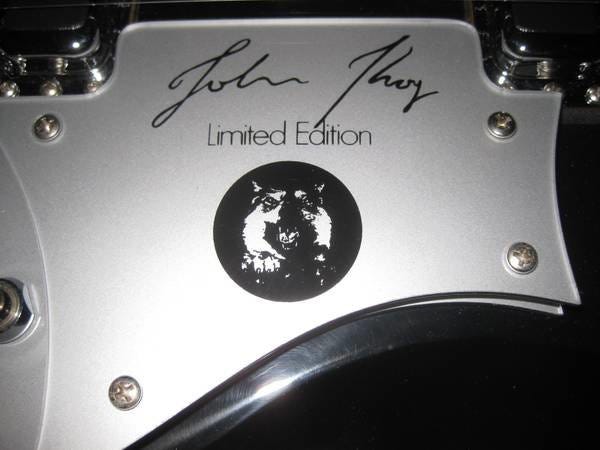
The “Signature/limited edition” branding introduced on the 370/12RM would carry over to the 381JK, although in this case the pickguard would be backpainted silver instead of white, as would the lower guard. And a Steppenwolf logo would be added at Kay’s request. All other features would be 381V69 standard with the exception of the truss rod cover, which was the black injection molded/raised silver letter cover found on the 200/2000 Hamburg models.
The 381JK was not as fast of a seller as many other models were, with 250 being produced between mid 1989 and late 1995.
Susanna Hoffs 350SH
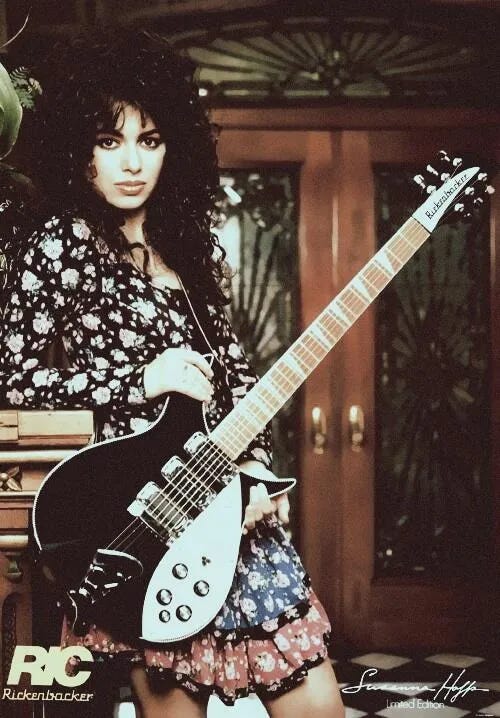
Susanna Hoffs Limited Edition Guitar Announced
Santa Ana, California (October 1, 1988) Rickenbacker International Corporation announces the acceptance of orders for the Susanna Hoffs Limited Edition. Susanna Hoffs, lead singer and song writer for the popular group, the Bangles, defined the appointments for this latest model.
The hand made instrument offers a number of features which make it unique in the Rickenbacker product line, including the pickup configuration with one HB1, Rickenbacker's new humbucking pickup and two vintage type "chrome bar" single-coil pickups; 24 fret fully inlaid Rosewood fingerboard and bound body with "checkered" binding. Other features include semi-hollow body design and neck made from solid Maple and Rickenbacker's exclusive dual truss rod system.
The company previewed the instrument at the 1988 Summer NAMM show in Atlanta. The list price is US$1279 with a custom hardshell luggage case at $129.
Susanna Hoffs has authorized the company to produce 250 of these unique instruments worldwide. Each guitar will be accompanied by an individually numbered Certificate of Authenticity. Certificate numbers will be assigned in the sequence that orders are received.
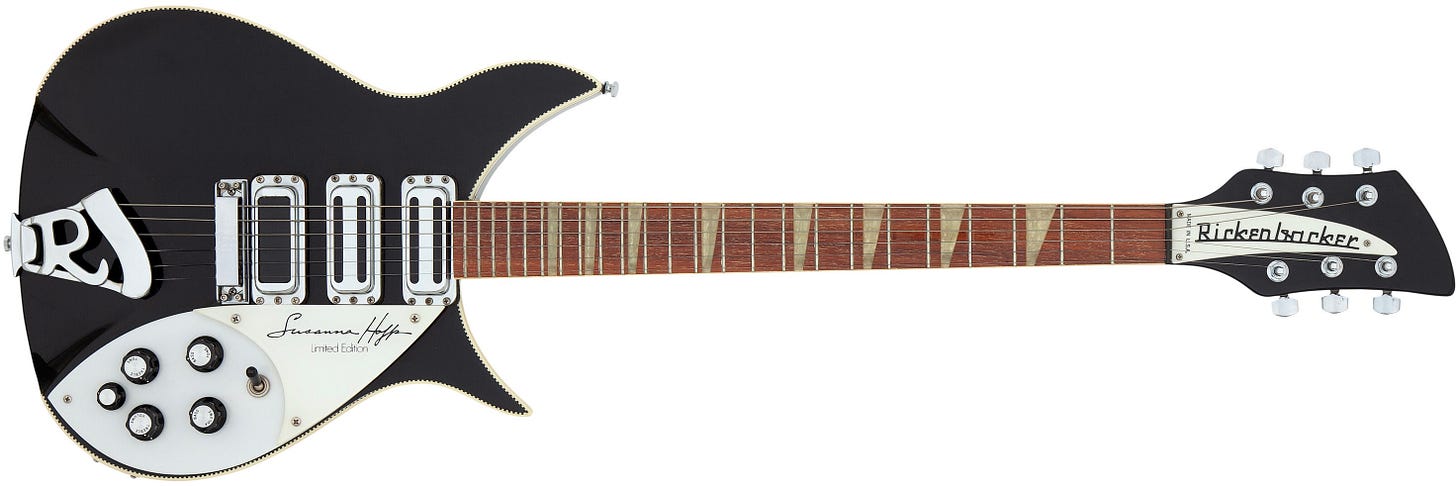
Introduced at the same time as the 381JK, the 350SH was another model designed in collaboration with the signature artist. Hoffs was no stranger to Rickenbackers, playing both 330s and 360s during the Bangles’ early days, but the smaller bodied 350 was a natural fit for the diminutive Hoffs.
Hoffs took the 350 Liverpool, added “deluxe” features like front and back checkered binding and a bound neck with full width acrylic triangle inlays, and changed out the Higain pickups for toasters in the neck and middle and an HB-1 at the bridge.
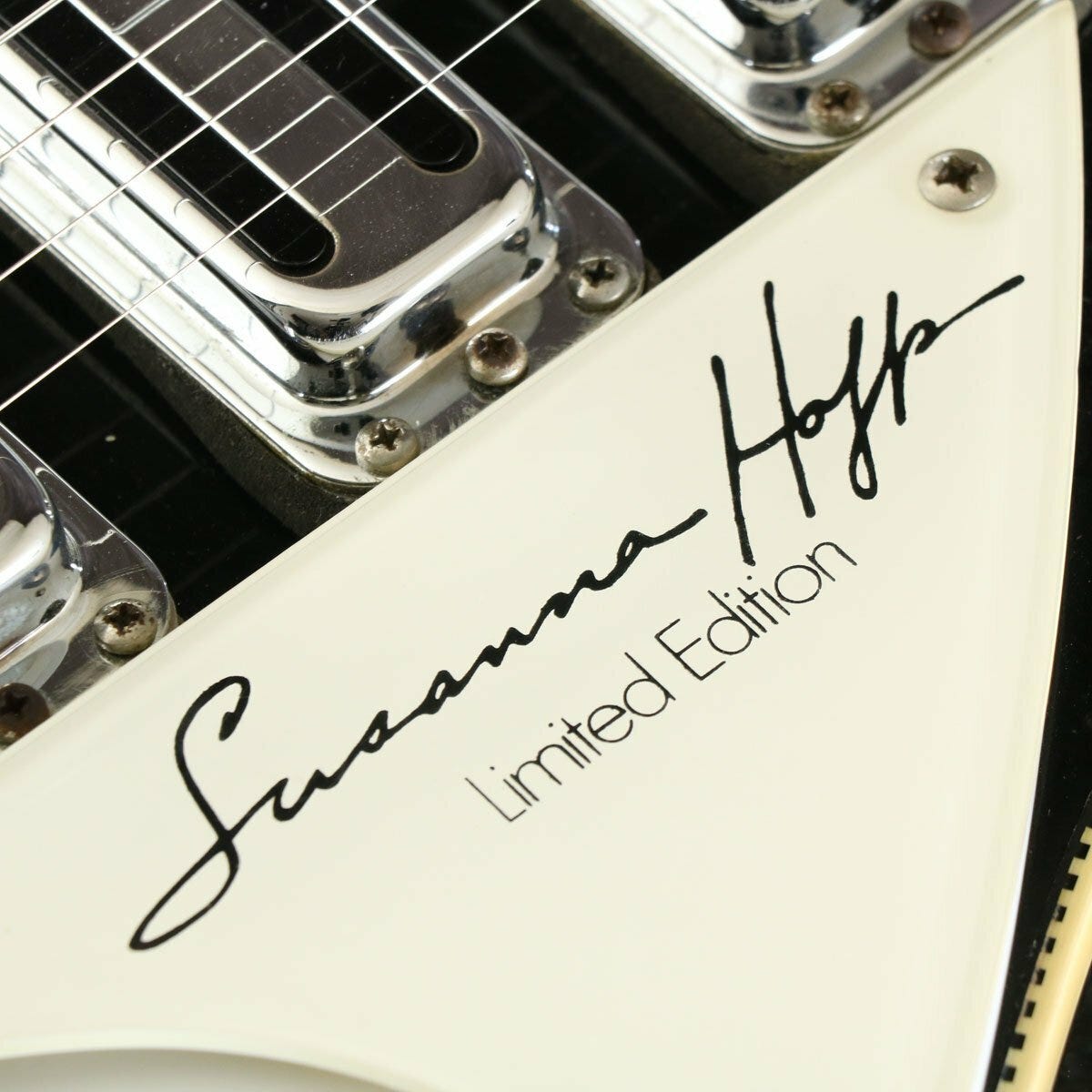
The now-standard signature/limited edition backpainted upper guard rounded out the special features. All other appointments were 350 standard. To date, no other production 350 has carried the deluxe features of the 350SH.
Note how in all the press releases up this point they still hadn’t quite standardized language around toaster pickups: the 1997PT’s were referred to as “vintage pickups”, the 370/12RM’s were “vintage Toaster Top™ pickups” and the 350SH’s were “vintage type ‘chrome bar’ single-coil pickups”.
The 250 authorized guitars were produced between early 1989 and early 1991.
John Lennon 325JL, 355JL, and 355/12JL
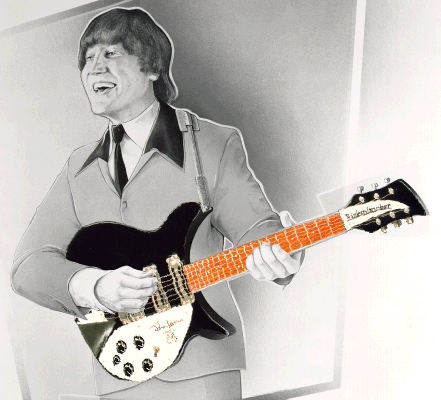
JOHN LENNON LIMITED EDITION; RICKENBACKER INTRODUCES NEW GUITAR
Santa Ana, California (January 1, 1990) Rickenbacker International Corporation announces the acceptance of orders for the John Lennon Limited Edition. As a rock 'n roll legend and spokesperson for world peace, John Lennon used the Rickenbacker sound almost exclusively during his early days with the Beatles.
The John Lennon Limited Edition, Model 325JL, is entirely handmade in America from solid Eastern Rock Maple with a rosewood fingerboard on a three quarter scale neck complimented with three vintage Rickenbacker pickups. The instrument comes standard with vintage vibrato. This series offers features which make it unique within the Rickenbacker product line. The Company located some of the original tooling to insure faithful recreation of the headstock, pickguard and nameplate. Also offered are the 355 JL and the 355/12 JL. The 355 JL is a full scale version of the 325 JL and the 355/12 JL is its 12-string compliment. Both guitars feature trapeze tailpiece. A special "vintage" case will be available with silver covering and crushed velvet interior similar to the original.
The Company will manufacture only 2000 instruments from this series.
The models will be formally introduced at the 1990 Winter NAMM Show in Anaheim. Pricing will be announced at the Show. Each guitar will be accompanied by an individually numbered Certificate of Authenticity and Origin. Production deliveries and certificate numbers will follow order sequence.
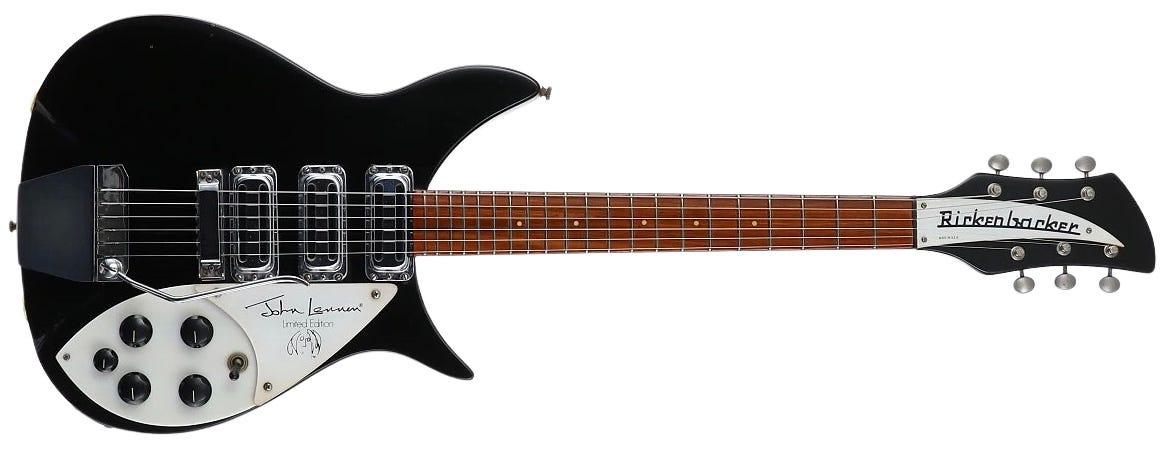
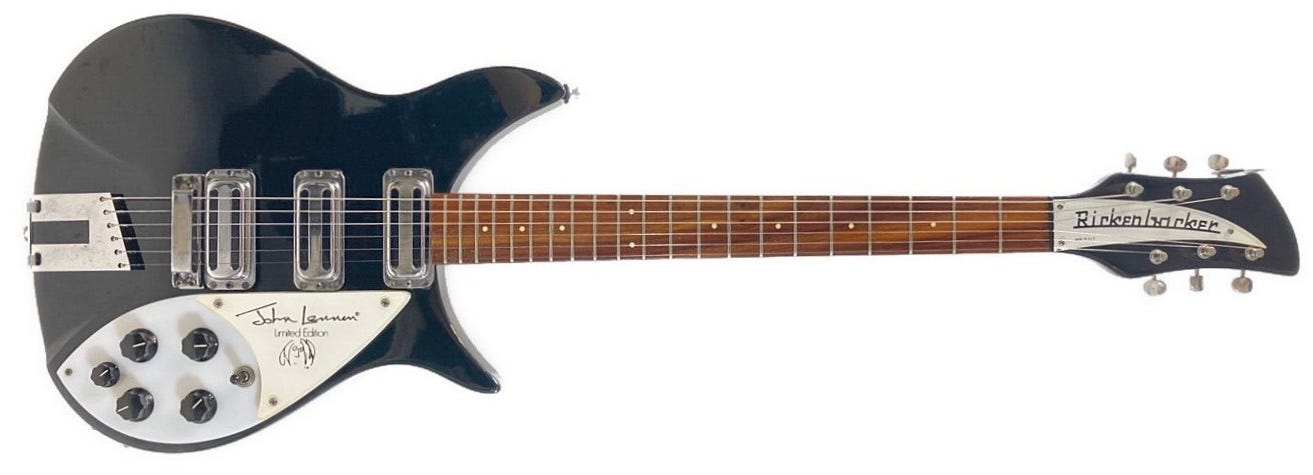
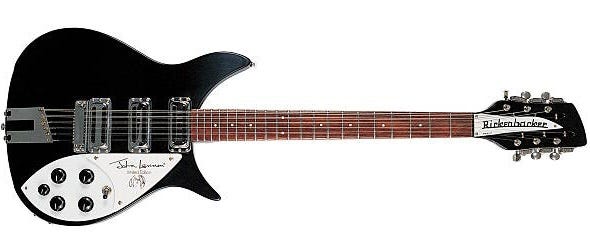
Without a doubt the least “special” of the Signature Limited edition models, the 325JL, 355JL, and 355/12JL took a production 325V63, 350V63, and 350/12V63 and put a special pickguard on them. That’s about all there is to say about them.

2000 units were produced between mid 1990 and mid 1993. The first guitar was delivered to Yoko Ono. For more information about Beatles inspired guitars, click HERE.
Chris Squire 4001CS:
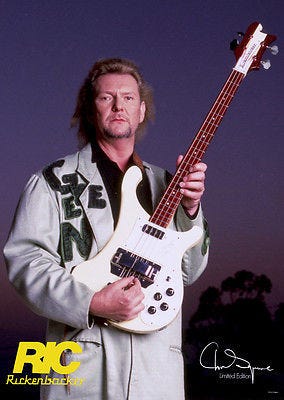
CHRIS SQUIRE LIMITED EDITION; RICKENBACKER INTRODUCES NEW GUITAR
Santa Ana, California (January 1, 1991) Rickenbacker International Corporation announces the acceptance of orders for the Chris Squire Limited Edition. Squire is best known for his work with the supergroup YES which has been the recipient of a Grammy Award and numerous platinum and gold records. Squire has been considered for many years to be the quintessential rock bass player. Rickenbacker teamed up with Squire to replicate and improve upon his legendary "Rick" bass which he has used to make great music with over the last 25 years. By including the custom modifications requested by Squire, this instrument will be produced with unique features never before offered on a Rickenbacker bass.
The Chris Squire Limited Edition, Model 4001CS, features neck through body construction using solid Eastern Rock Maple, a contoured body, dot inlays, precision tuning keys and Rickenbacker's famous tailpiece/bridge. The neck has been shaped to meet Squire's specifications and match his original bass. The head stock and fingerboard are sculpted from the same piece of solid African Vermilion to insure consistency in grain and wood tone. The limited edition is finished in a special cream lacquer to match the custom color Squire commissioned on his own bass from an English luthier in the early 1970's. The Company has never offered this color before. A Rickenbacker vintage case is included with each instrument.
The model will be formally introduced at the 1991 Winter NAMM Show in Anaheim. The Company will manufacture only 1000 of these instruments. Each bass will be accompanied by an individually numbered Certificate of Authenticity and Origin. Production deliveries and certificate numbers will follow order sequence. The suggested list price is US$1899, which includes a hard-shell vintage reissue case.

One of the most famous bassists indelibly associated with Rickenbackers, Squire’s modified 1964 Rose Morris 1999 was a prime candidate for a Signature Limited Edition. Today they are highly prized by by collectors for their thin necks—much thinner than period 4003s.
Featuring a reproduction “horseshoe” pickup that first appeared on the 4001V63–which was in itself a reproduction of another 1964 1999/4001S—and a toaster neck pickup, the 4001CS’s most striking feature is its dark vermillion fretboard and headstock wings offsetting the cream paint Squire’s original had acquired over the years.
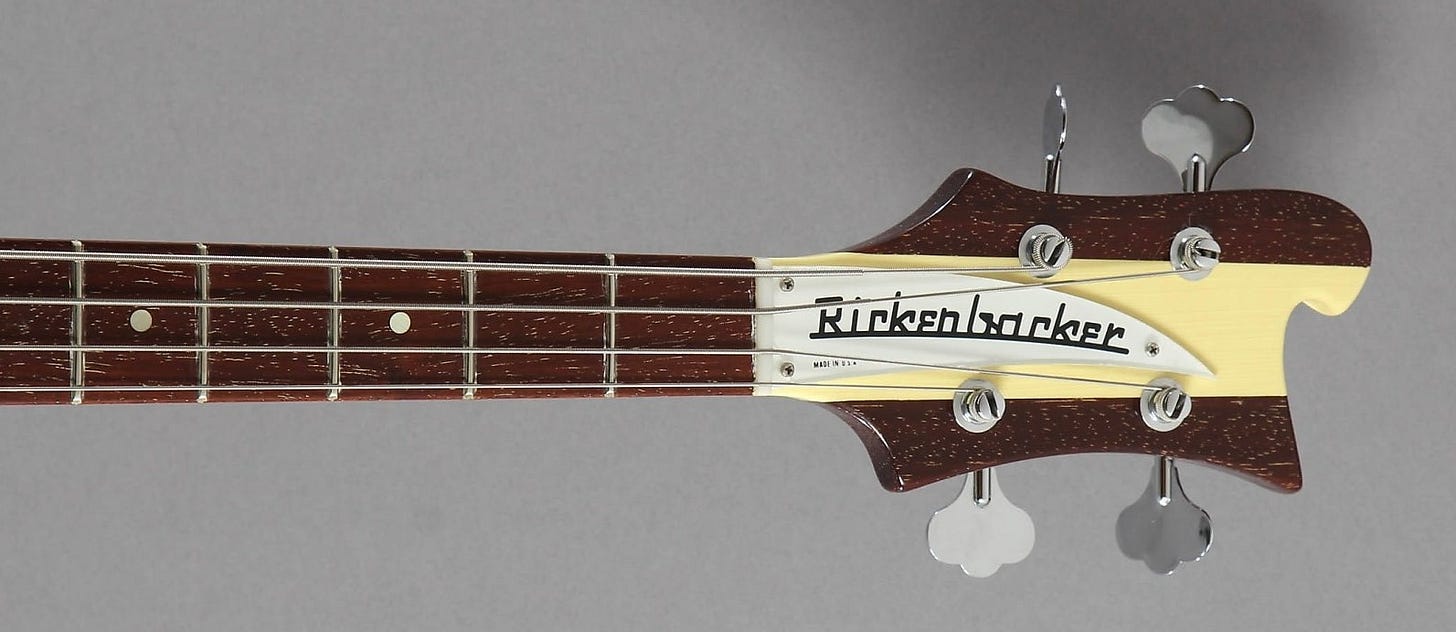
Or are they? Despite what the press release says, John Hall is on the record as saying “nope”. Vermillion is a term most commonly associated with woods like padauk or pao ferro, and Hall says neither was used here. No matter what it actually is, it’s much darker than the woods normally used here and really makes the model stand out.
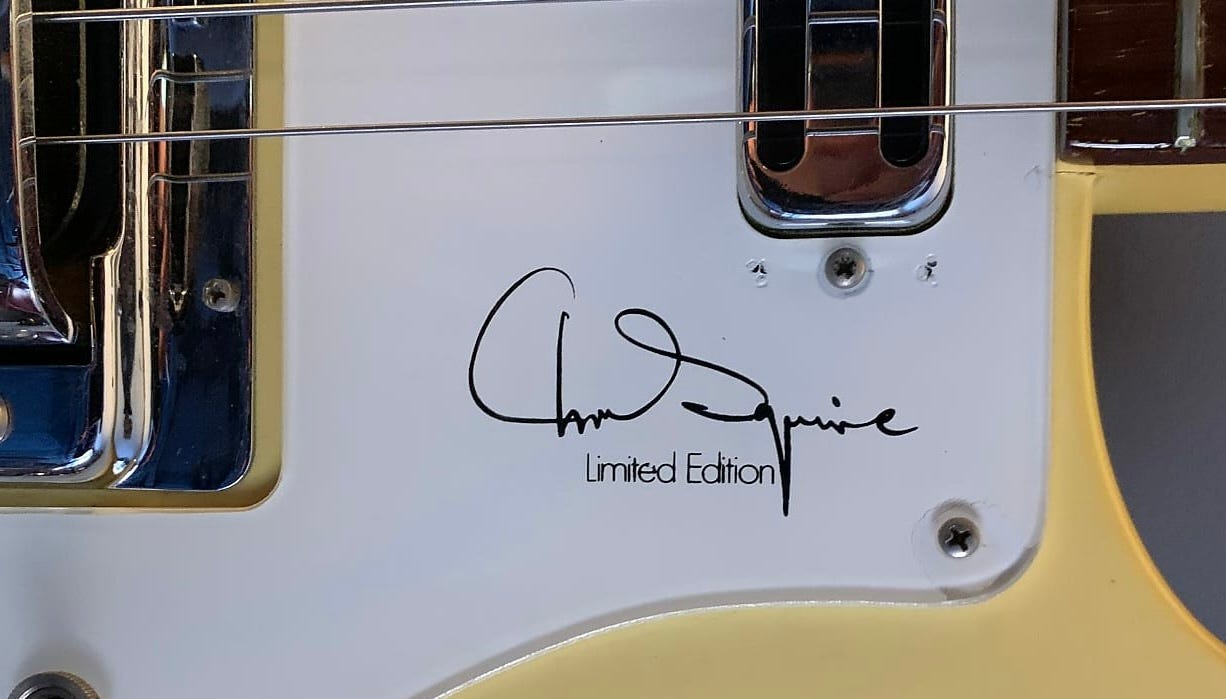
Another unique feature to the 4001CS is the first backpainted plexi truss rod cover since the “modern” 4001/4003 design was finalized around 1963. And as anyone who has ever removed a backpainted plexi truss rod cover can tell you, the paint can adhere to the guitar near the screws and pull off when you remove the pickguard. In the example above, we can see the imprint of the corner screws from the neck pickup in the paint as well. Meaning that examples with unmarked pickguards are rare indeed today.
1000 4001CS models were produced between early 1991 and 2000. With such a long production period some slight changes occurred over time, most notably with earlier guitars tending to have thinner necks than later examples
Tom Petty 660/12TP:
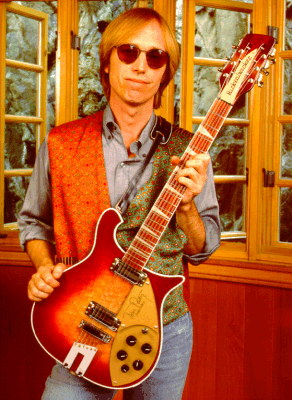
TOM PETTY LIMITED EDITION RICKENBACKER
Santa Ana, California (January, 1991) Rickenbacker International Corporation announces the acceptance of orders for the Tom Petty Limited Edition. As leader of the world renown "Tom Petty and the Heartbreakers", Petty has furthered his professional accomplishments with the "Traveling Wilburys" and the success of his recent solo album, Full Moon Fever which has sold over five million copies worldwide.
The Tom Petty Limited Edition, Model 660/12TP, is entirely hand made in America from solid "charactered" Eastern Rock Maple with a fully inlaid 21 fret rosewood fingerboard. Using neck through body construction, this 12-string instrument features "checked" binding, vintage pickups, vintage knobs, gold pickguard and nameplate, vintage keys designed to Rickenbacker specifications, trapeze tailpiece and a 12 saddle bridge. The neck on the 660/12TP was designed to Petty's demanding standards. A Rickenbacker vintage case is included with each instrument. The instrument is available in Fireglo and Jetglo. Information regarding price may be obtained from the local Rickenbacker distributor.
The company previewed the instrument at the 1988 Summer NAMM show in Atlanta. The list price is US$1279 with a custom hardshell luggage case at $129.
The model will be formally introduced at the 1991 Winter NAMM Show in Anaheim. The Company will manufacture only 1000 of these instruments. A poster commemorating the Tom Petty Limited Edition will be available through authorized Rickenbacker dealers. Each guitar will be accompanied by an individually numbered Certificate of Authenticity and Origin. Production deliveries and certificate numbers will follow order sequence.
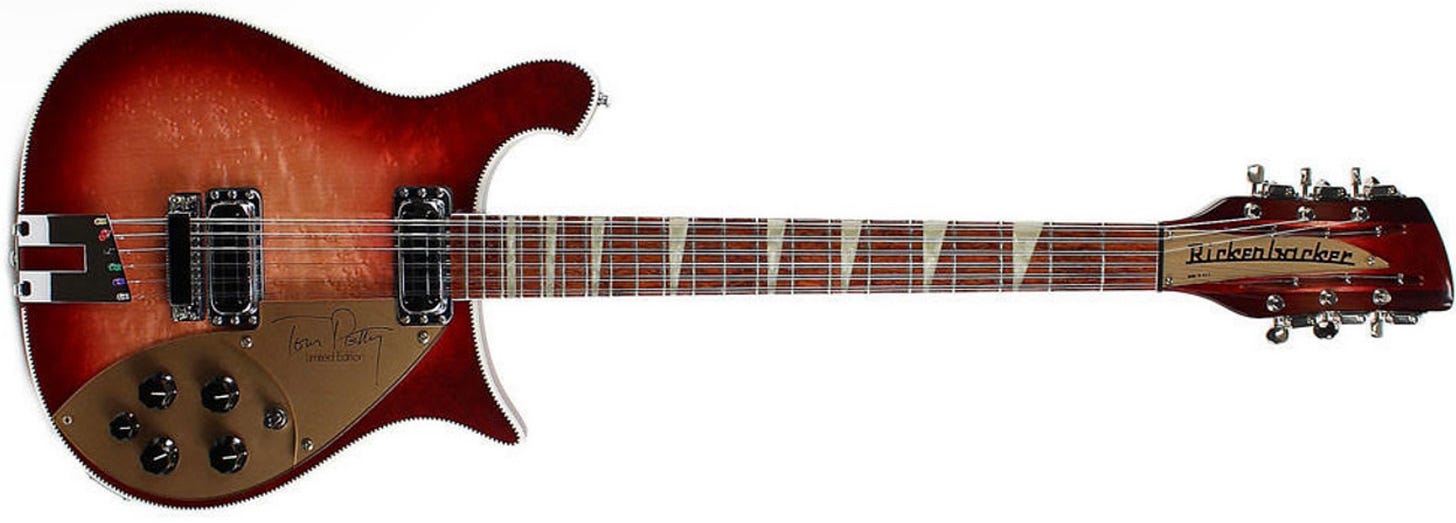
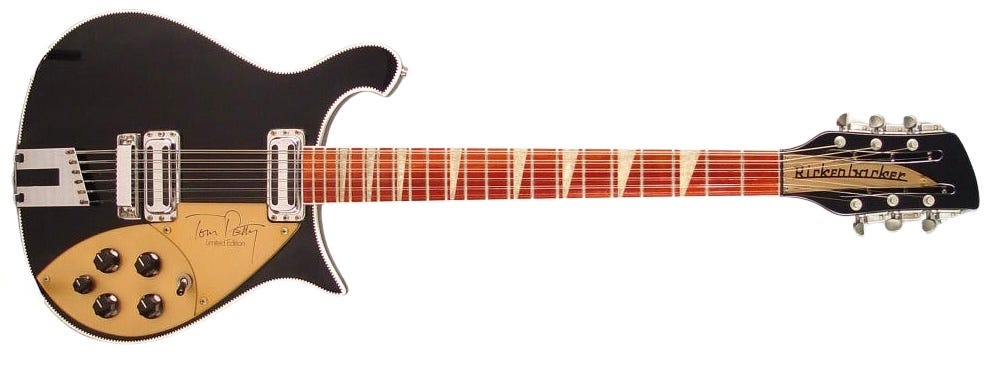
While all models up to this point followed either a “reproduction of/inspired by” or “artist specification” pattern, the 660/12TP somehow managed to do both at the same time.
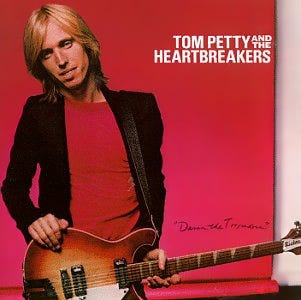
While clearly inspired by Heartbreaker Mike Campbell’s 1963 620/12 (the third 12 string Rickenbacker ever made) featured on the “Damn the Torpedoes” cover, changes both cosmetic and structural created a whole new guitar.
Checkered binding and gold plastics were an aesthetic change from the original, but the biggest change was in the neck, which at a 1 3/4” nut width is 1/8” wider than a standard Rickenbacker neck—which may not sound like a lot, but on a cramped Rickenbacker neck feels like a lot. This nut width would go on to appear on the 650 line and the 1993 Plus—a second Pete Townshend-inspired model.
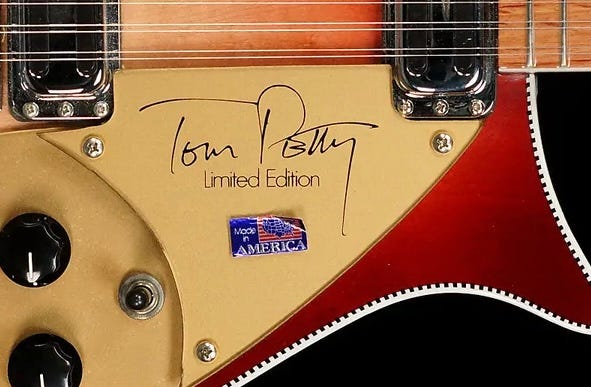
The 660/12TP would be so well received that the model would carry on in 12 and 6 string form after the agreed-to 1000 were produced, losing the “TP” designation and signature pickguard—a fact Petty was a little chippy about as he no longer earned a royalty on the continuation model. The 660 and 660/12 remain in the line to this day.
1000 660/12TPs were produced between early 1991 and late 1997.
Glenn Frey 230GF and 2030GF:
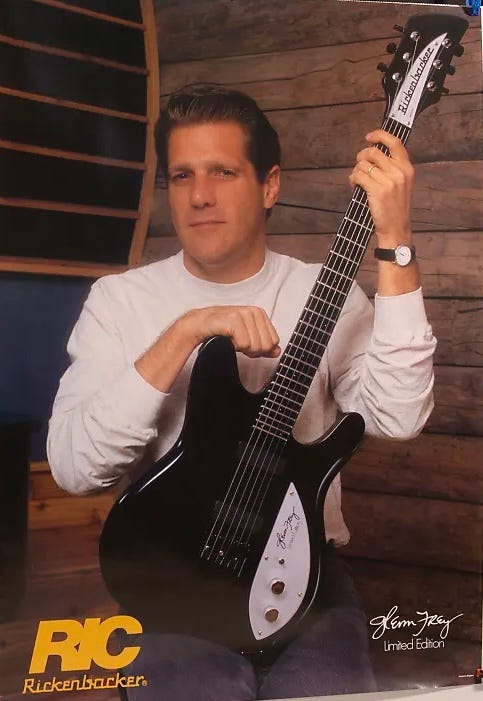
Glenn Frey Limited Edition Model 230GF
Glenn Frey, international solo recording artist and co-founder of the legendary "Eagles", joined with Rickenbacker to create the "guitar of his dreams". Reflecting a vision of returning to simplicity in an era of ever-increasing complexity, Glenn and the RIC design team created a guitar of exceptional honesty, utility, and durability while avoiding both austerity and garishness.
The Glenn Frey Limited Edition guitar, designated respectively as the 230GF, borrows the basic body outline from Rickenbacker's futuristic Series 200/2000 solid body instruments, but further refines the shape with extra contours for comfort. The body, neck, and 24-fret fingerboard are sculpted of solid Maple which is then entirely encased in an ultra high gloss jet black finish. Highly polished wide frets contrast with the slick, gleaming fingerboard. The two high output humbucking pickups are uniquely voiced to offer an exceptional breadth of tone, ranging from the warmest to the brightest. A most useful combination of pickup selector, single volume and tone controls further refine the voice of these instruments. Euro-black parts are used throughout, graced with subtle touches of chrome for distinction. The silver nameplate and pickguard with Glenn Frey's signature complete the look of elegant simplicity.
"After more than 20 years in the crazy and complex world of the music business, my joy is a return to the natural, simple life of writing and recording in Colorado and I wanted this to be reflected in my 'ideal' guitar.
"The shape is contoured for ease and comfort, the appearance striking, but subtle. The high output humbucking pickups provide a wide range of tones, from the warmest to the brightest, with a simple combination of tone and volume controls - in other words, a guitar for everybody to enjoy. This guitar truly represents a return to simplicity. I can get all the sounds I want, and more, from these instruments without clutter or complexity."
"I hope you get as much pleasure from playing them as I do."
-Glenn Frey
A total of only 1000 of these guitars will be produced, each including a certificate of authenticity. The first 100 certificates are personally autographed by Glenn Frey. Complete with a deluxe hardshell case, the Model 230GF retails for $ 1199
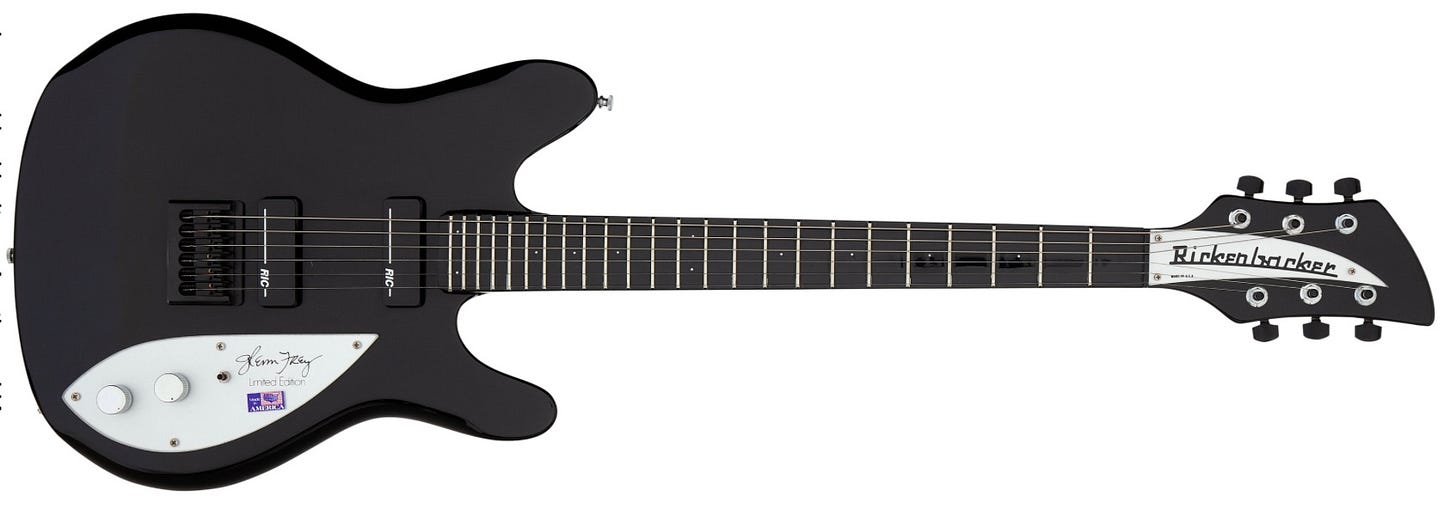

Another entry in the “artist specification” category, the 230GF was something new for the Signature Limited Edition series: a flop.
Don’t get me wrong: it’s a cool looking little guitar, especially with its black-finished-fretboard-with-white-dot-markers, but it had three fatal flaws: it was the Signature model of an artist not especially associated with Rickenbacker based on a model that was not well loved by Rickenbacker fans, and it had HB2 humbucker pickups. So it didn’t look like a Rickenbacker, sound like a Rickenbacker, or belong to anyone you’d associate with Rickenbacker.
Funnily enough, the 230GF isn’t even technically a 230. The 230 Hamburg was the first version of the bolt-on neck “value” 200 Series. It featured a lightly contoured top, no pickguard, and 4 knob/1 switch control. It was replaced by the 220 Hamburg in 1992, which featured a highly contoured top, a single layer teardrop pickguard, and 2 knob/1 switch controls. Sound familiar?
Now it does have a couple other cool design features apart from the black finished board: black and silver tuners and the only silver truss rod cover in company history.
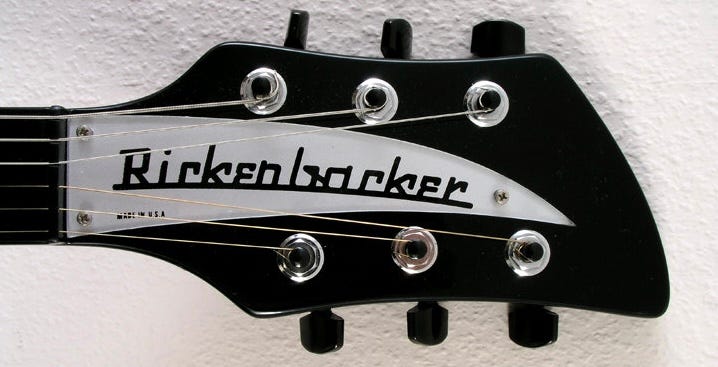
Although not mentioned in the press release the 2030GF bass was part of the line as well because…why not?
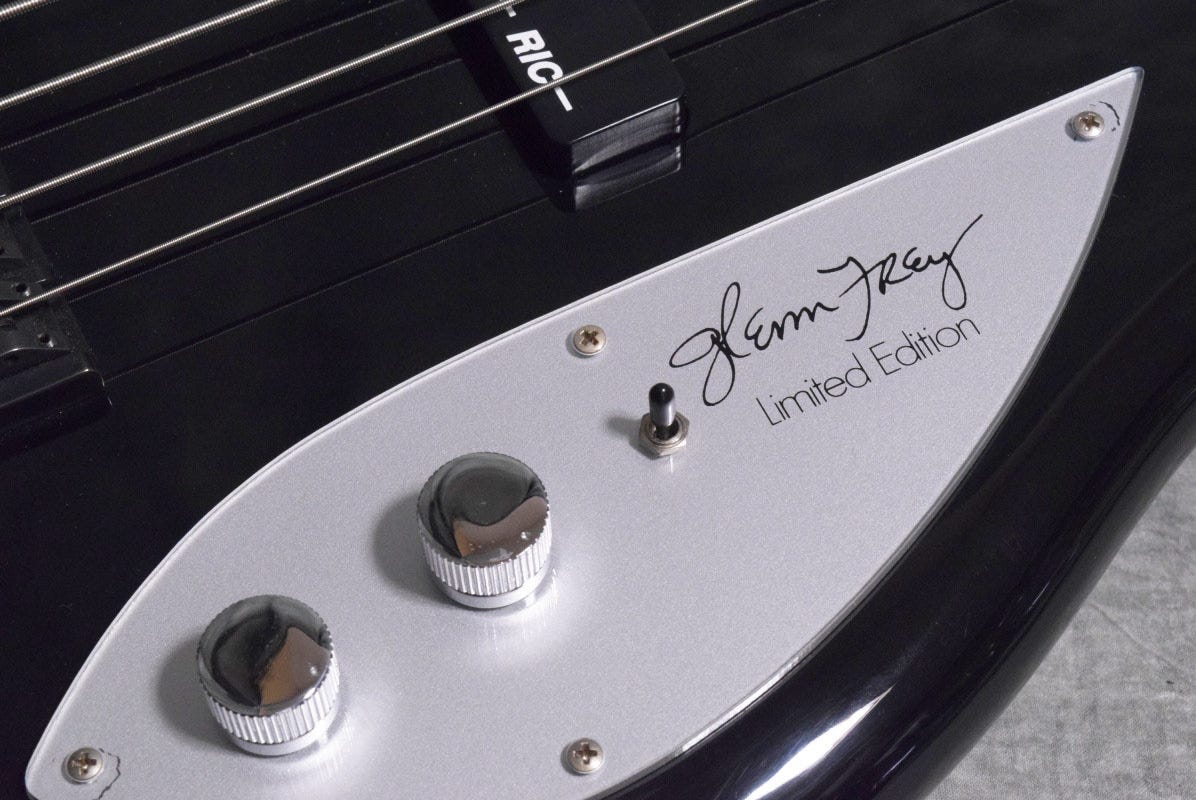
The press release said 1000 would be built. Production began in early 1992 and would end in early 1999. The highest production number on the register from 1999 is…229. So around 250 produced over a 5 year run. Hey, Joe Walsh plays one! Glenn probably had a couple spares laying around…

Carl Wilson 360CW and 360/12CW:
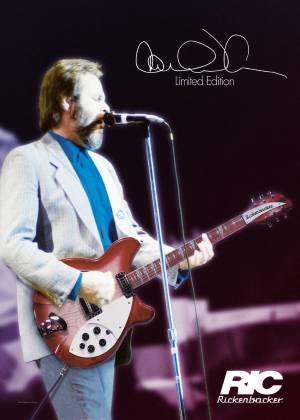
Santa Ana, California February 3, 2000:.Rickenbacker International Corporation announces acceptance of orders for the Carl Wilson Limited Edition Guitar. This handmade instrument is similar to the guitar Carl Wilson played in the 60's. As one of the founders of the world renowned Beach Boys, this guitar played an extensive role in creating their early sound. The guitar offers a number of classic features that makes the product stand out from other Vintage Reissue guitars.
The company is authorized to manufacture 500 of these classic instruments. Each guitar will be supplied with individually numbered certificates of authenticity. A portion of the proceeds will go the Carl Wilson Foundation.
The specifications of these guitars are:
Similar to the model type 360 as produced in 1965
Offered both in six and twelve string versions, as Model 360CW and 360/12CW
Carl Wilson's signature reproduced on the upper pickguard
Checked body binding
Offered in Fireglo and Jetglo colors
Wood is specially charactered maple body with Rosewood fret board
Special thin top for increased acoustic performance
Twenty-one fret neck with vintage inlays
Vintage style square heel
Two scatter wound vintage-style pickups with 7.4K ohm coils
Dual mono parallel output
Vintage reissue silver Tolex guitar case
US Suggested List Price: 360CW US$1,999 360/12CW US$2,149
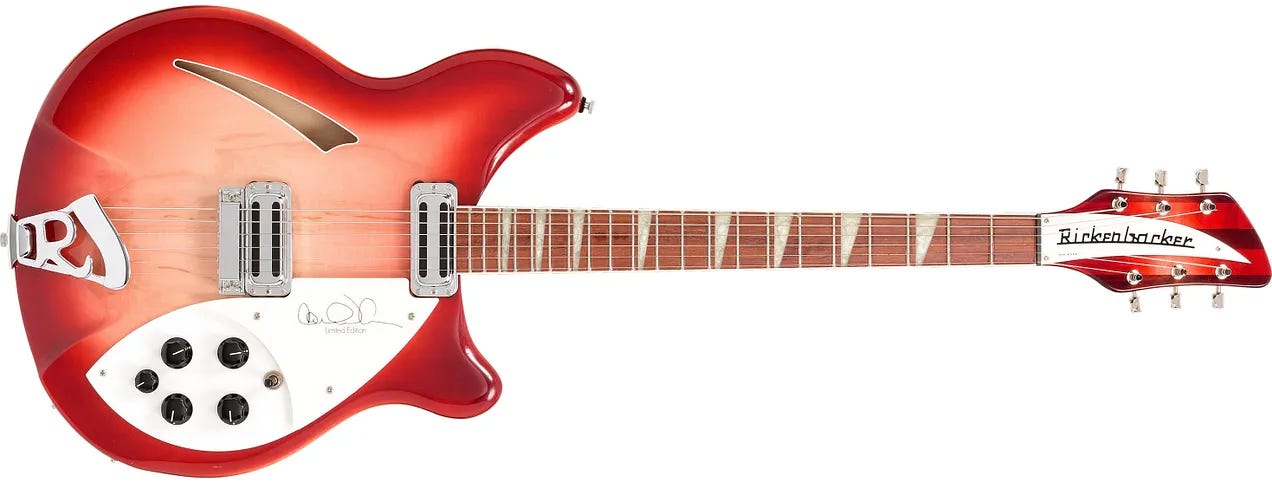
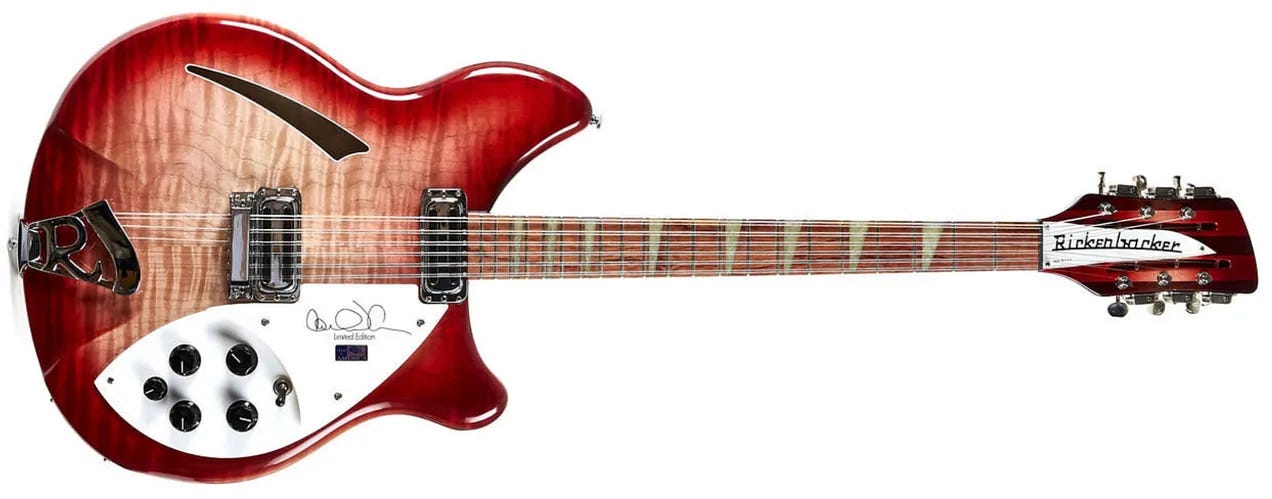
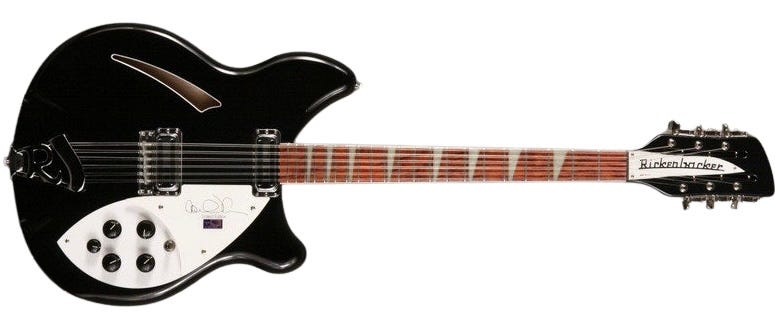
This is the one that people who want vintage looks and sound but not vintage prices want. Even if Wilson’s link to Rickenbacker is tenuous in most peoples’ minds, of all of the “reproduction/inspired by” Signature Limited Edition models, the 360CW and 369/12CW are the most accurate reproductions hands down.
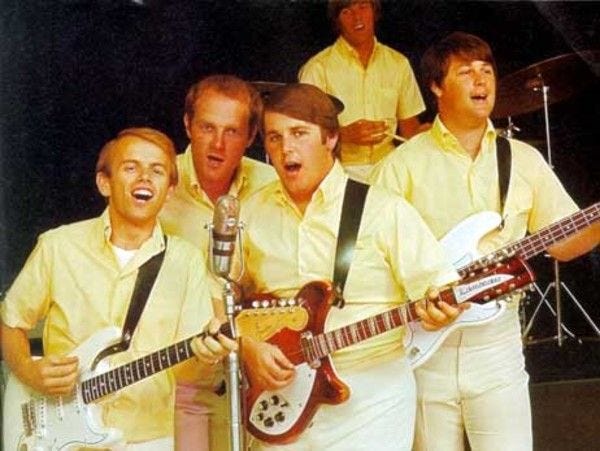
Modeled after a 1965 360, the 360CW and 360/12CW nail almost all the period details—most notably the then newly released scatterwound toaster pickups and the thin top no “vintage reissue” model before had worn (although, unlike the CW, no “New Style” 360 ever featured a square heel). Add to that very (period incorrect!) flamey maple tops on most Fireglo examples and you have a guitar that looked great and sounded exactly like what it was trying to emulate.
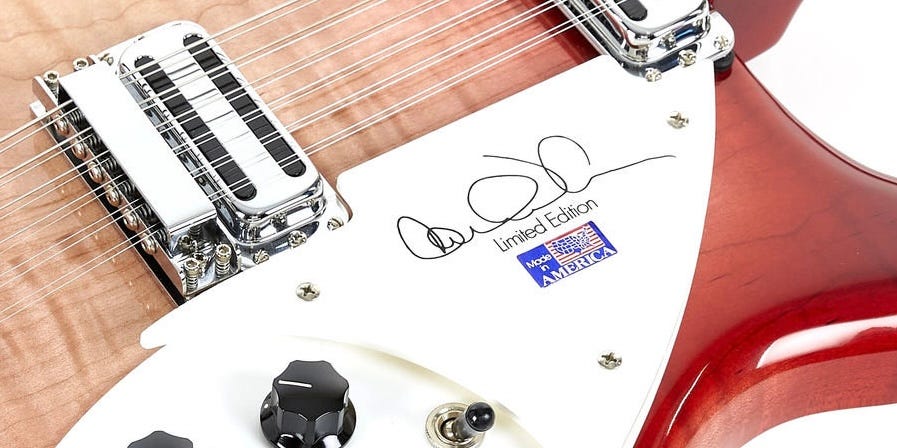
500 total were produced in 6 string and 12 string versions between early 2000 and late 2001.
Lemmy Kilmister 4004LK:
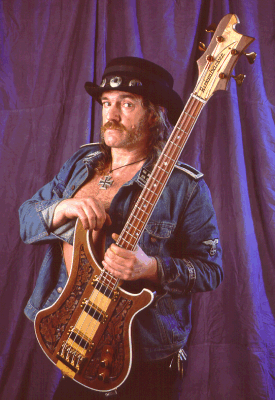
What else could replace Lemmy’s iconic Rickenbastard bass but another Rickenbacker, built to his exact specifications?

To quote John Hall, “I told Lemmy that it was a bit over the top. Gilding the lily. Sorta like a hooker overloaded with lace and gold jewelry. He said ‘And that's bad, how?’”
The rarest of the Signature Limited Edition models—and the longest to germinate—the edition was limited to 50 units…which was later extended to 60 due to issues/changes within the Rickenbacker distribution network.
First announced and prototypes built in 1995, deliveries did not begin until 2001. The culprit? That top.
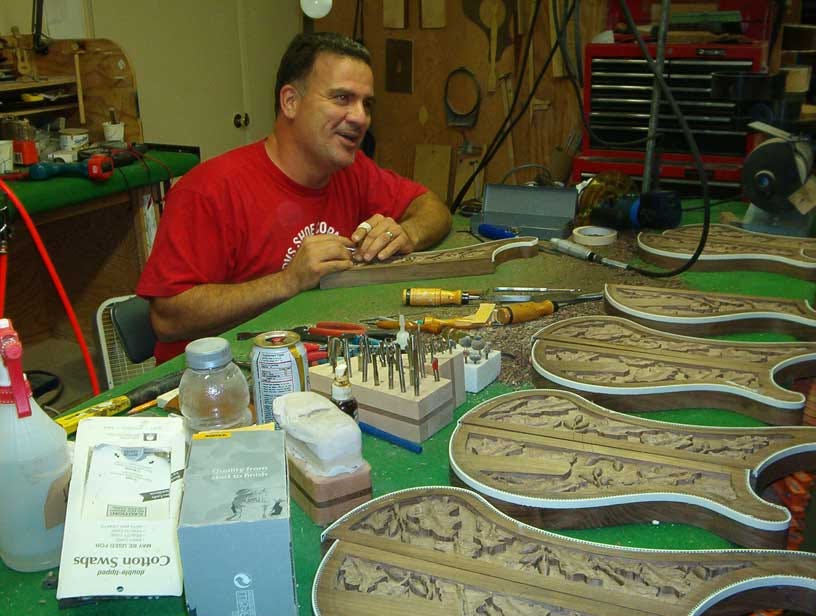
At its heart, the 4004LK was a 4004 Cheyenne with its maple through neck and walnut wings, but along the way some stuff happened to it. The oak leaves and acorn top was hand carved and that turned out to be a chore, with 4 separate artists required to complete over the years. They played with utilizing CNC equipment to do the complex work, but eventually abandoned the idea as too complicated to program.
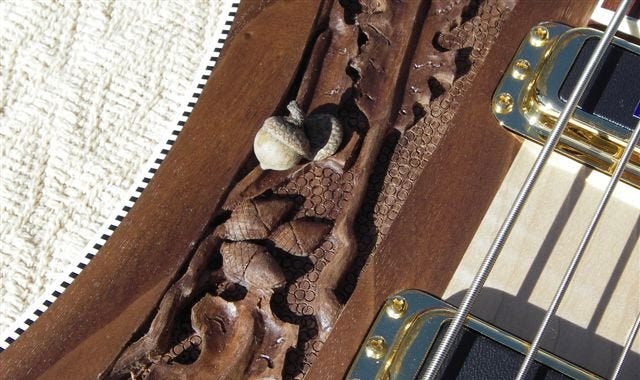
As a truly handbuilt instrument, variations from instrument to instrument abound—even in terms of pickup placement—of which there were three, all HB-1s, wired in the traditional Rickenbacker 3-pickup method. Controls were limited to 3 way pickup selector, master volume and master tone.
Other “lace and gold jewelry” included checkered top binding and star inlays on the bound neck. As there was no pickguard on the guitar, the 4004LK was the only Signature Limited Edition (apart from the 1997PT) to not feature a signature.
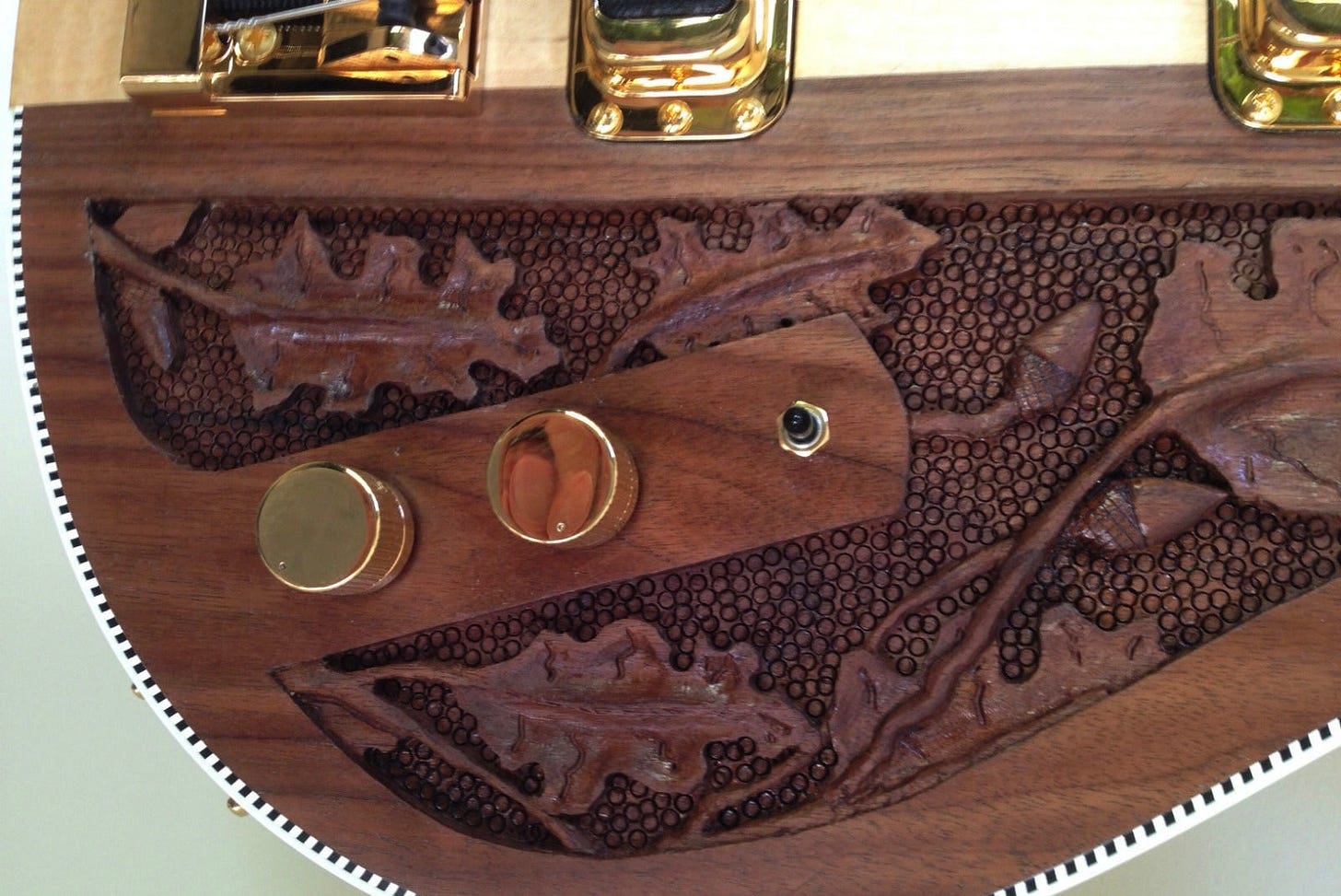
Around 60 were produced between 2001 and 2006.
Al Cisneros 4003AC:
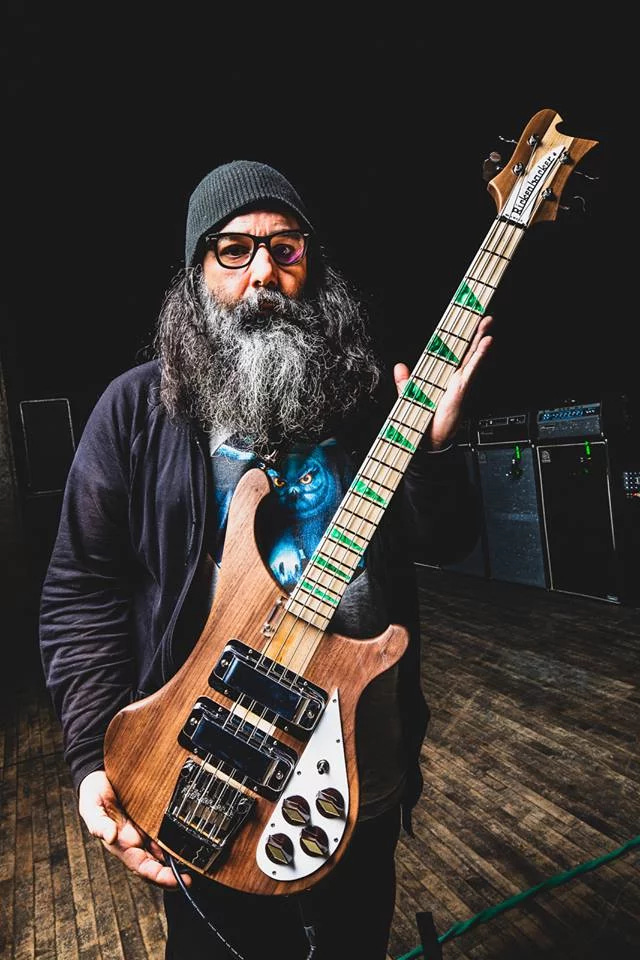
The first Signature Limited Edition in almost 20 years, and the first under Ben Hall’s guidance, the Al Cisneros 4003AC was a polarizing choice when it was first unveiled in 2019.

Truly designed with the artist’s input and optimized for his style of play, the 4003AC isn’t for everyone with its double covered pickups and jokey “they’re green because marijuana” inlays, but for the former Sleep and Om bassist—a long time Rickenbacker player—it’s a perfect fit.
Based on a 4003SW, the 4003AC also introduced a now standard Rickenbacker bass feature: the much improved V2 bass bridge
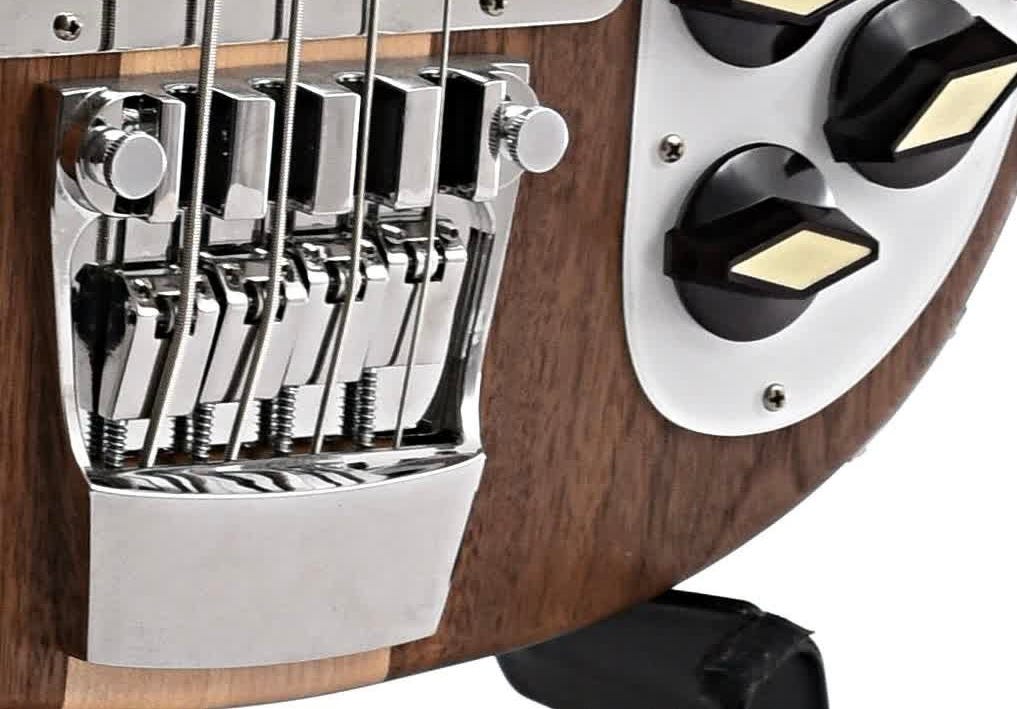
Truth be told, as polarizing as the looks were at first, when the key design elements are rendered in more “traditional” form—as is the case in this 2020 special run—the guitar is actually quite striking.
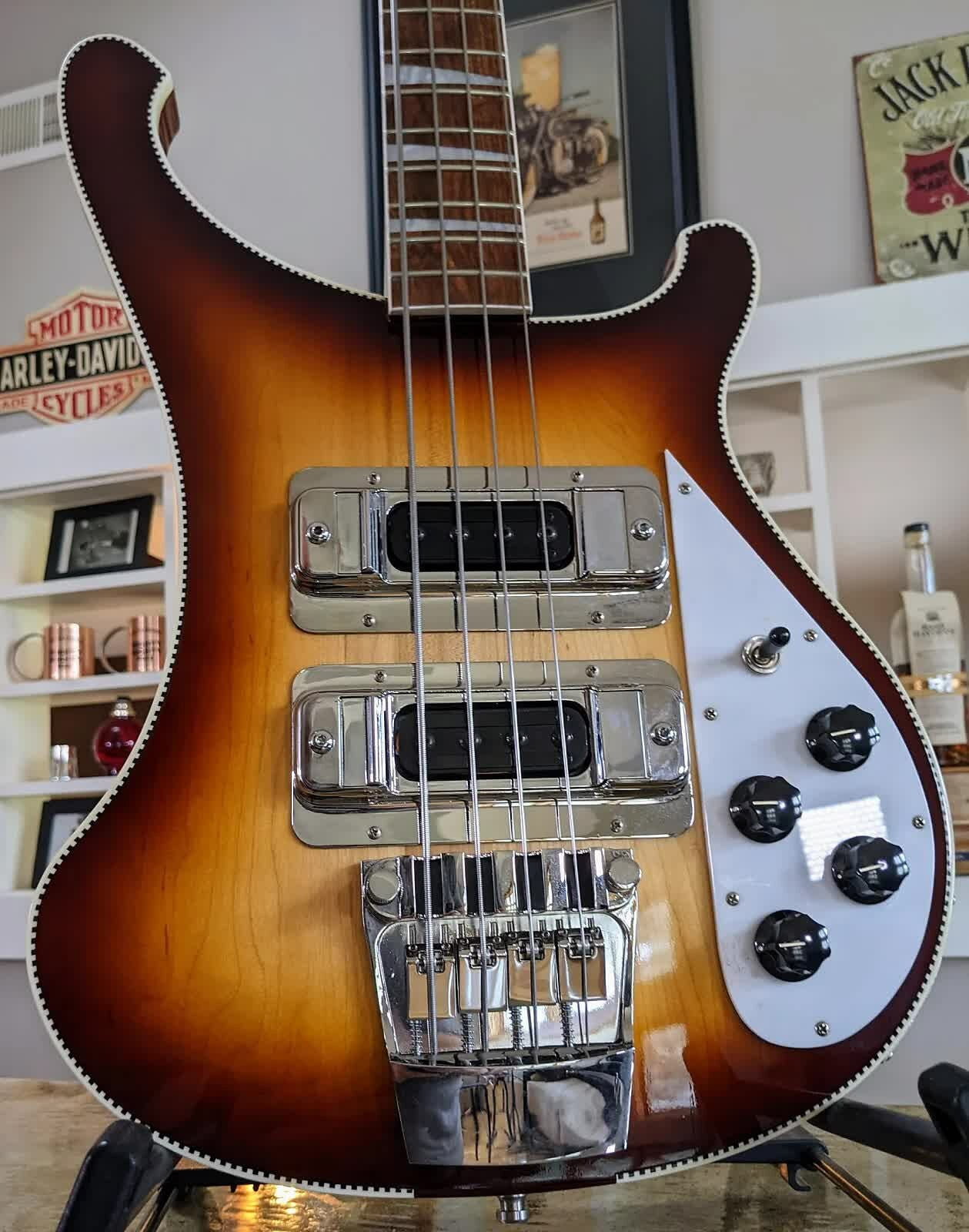
The 4003AC also began the transition for all basses from the dual truss rod system to a single dual action rod. Whether that’s an upgrade or a downgrade I’ll leave to you
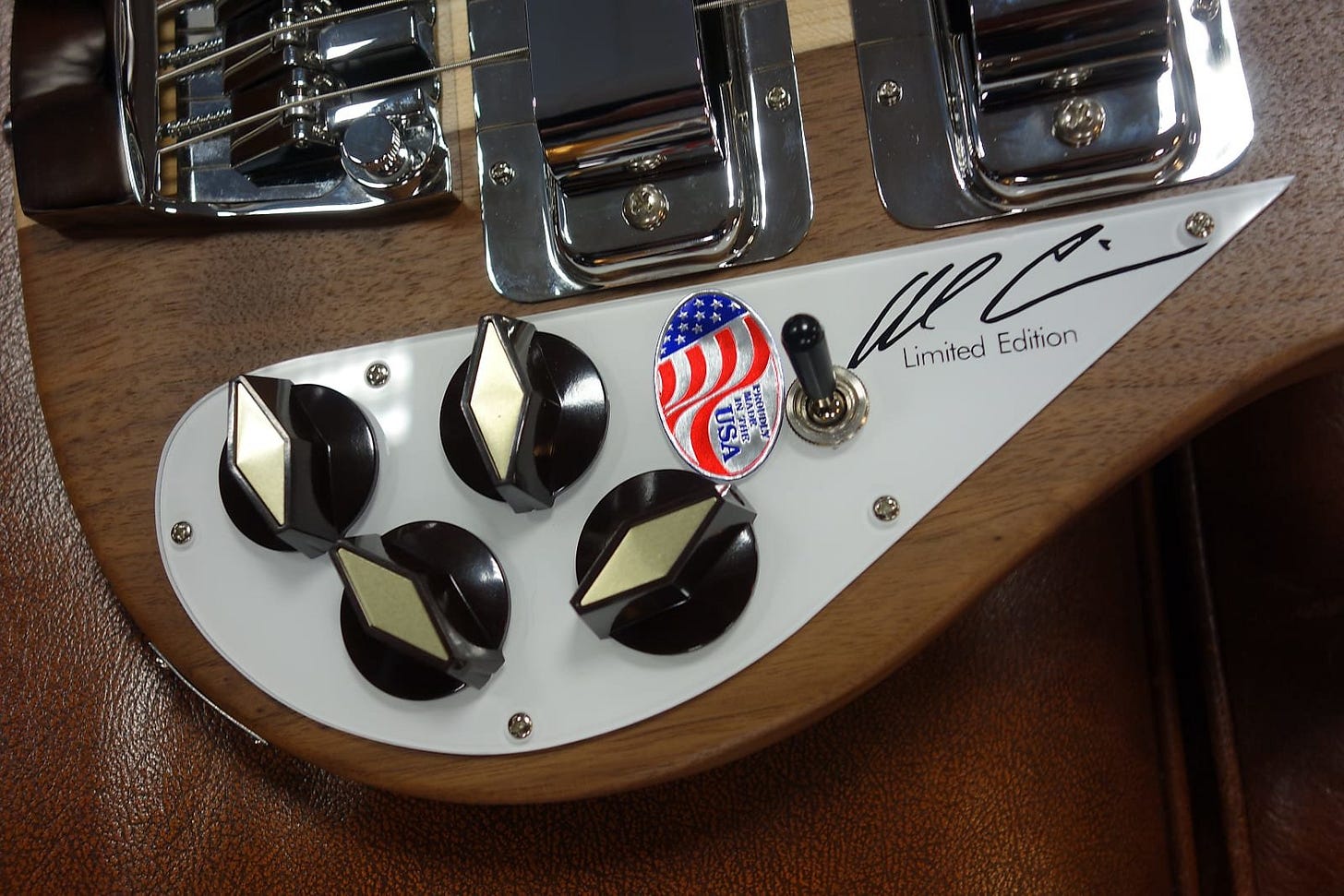
Limited to 420 (get it?) units, production began in mid 2019 and concluded in mid 2024.
And that is the complete list of Signature Limited Editions as it exists today. Now, we’re aware of prototypes that didn’t make the cut—like a white 350SH and a “Blackstar” 350JK—and there are multiple versions out there of a Jackson Browne model that never came to pass. But as of today, this is what we’ve got. I assumed that “era” was over, but with the “recent” 4003AC, who knows!
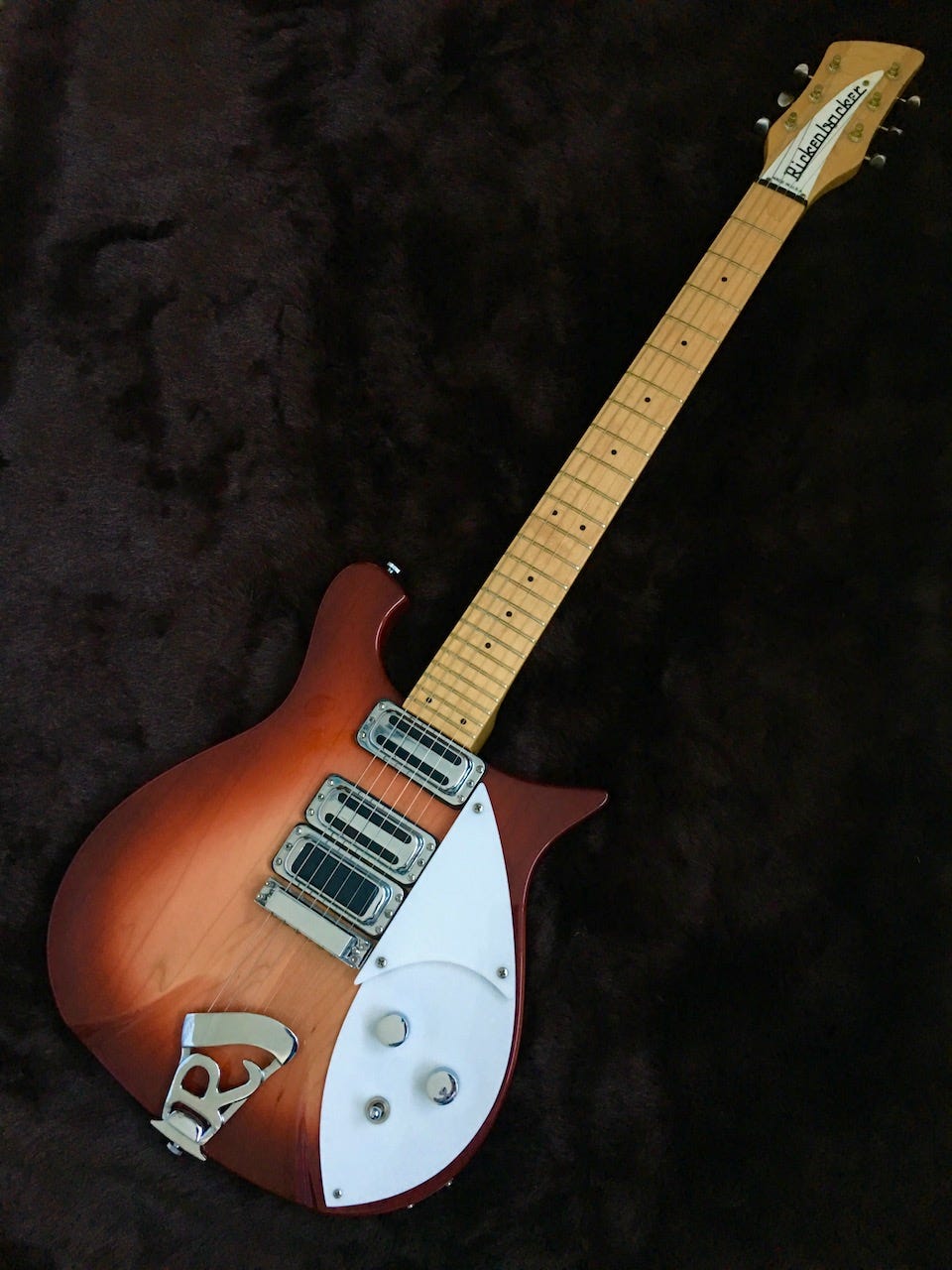




Nice work. I’ve seen one McGuinn “overrun”, as I coined these 25 years ago, with a serial number from 1995- B8 9500. The rest I’ve seen are in the 1990-93 range.
The 4001CS in the RIC poster is my bass which I “intercepted” when it was on its way back to California after the Jan 1991 Frankfurt Music Messe. A friend heard about the announcement of a Chris Squire Ltd Edition and as luck would have it we had a UK Rickenbacker office in Bury Lancashire just a few miles from me on the other side of Manchester so I rang for details. They said they had at their office the only CS built so far which had been on display at Frankfurt. I said “can I buy it if I ring Anne Mellor at AI Music Manchester?”. They said “OK but can you wait till the weekend as Chris Squire is going to pose with it for the official poster and Guitarist Magazine?”. I agreed and four days later I picked the world’s only CS up at A1 Manchester for £1199. A bargain! It had no certificate (they hadn’t done any at that point) and it was built in August 1990. John Hall said there was no prototype so I call in #1.